










Dear Fellow Alumni,
How did you choose your career? Do you remember a conversation or an experience that sparked your career path? Perhaps it was intentional or even accidental.
We are hearing from so many students and young alumni who are grappling with choosing their career. They are feeling pressure to both explore to see what they might like but also feeling like it all needs to be figured out. Increasingly, they are coming back to Bronx Science to see how the alumni network can help them.
We live in a unique time and place in history—and the world—one in which we have the freedom to choose our own career paths. For many of our Bronx Science students and alumni, they are the first in their family to get to make that choice and have so many options to explore. While this is an immense privilege, it can also be a daunting prospect.
Our Summer Institutes are designed to help students learn about careers and meet alumni in a supportive environment. Students hear from outstanding speakers, go on engaging field trips and connect with each other while learning about different industries. The Summer Institutes are completely funded by the Bronx Science Foundation and all of the content is delivered by our alumni. We encourage everyone to volunteer! Whether it’s hosting for the day, giving a tour of your office or speaking to our students, it is a great way to give back. For alumni, we host receptions locally, regionally and internationally to help bring alumni together. We are always looking to expand our career offerings to alumni and would love your suggestions about what else you would like to see.
Hope to see you all at a Summer Institute this year!
Best,
Eleanor L. Coufos ‘99
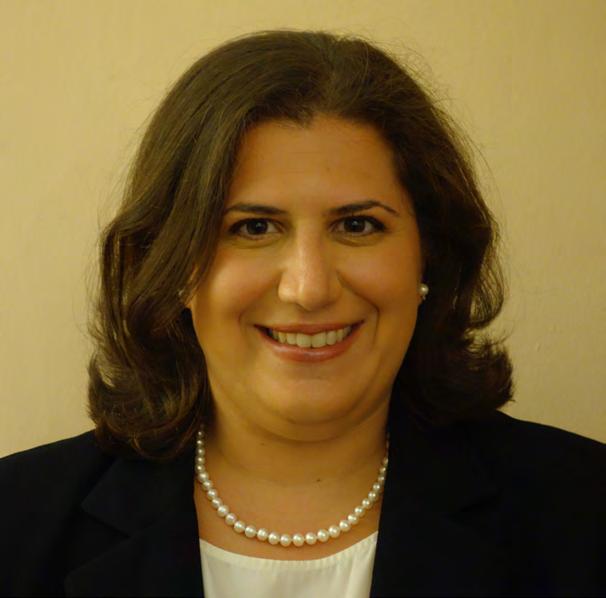
We are thrilled to report that alumni, parents and friends have continued to generously display their support for Bronx Science and the Foundation’s work, with gifts totaling more than $1.2 million so far in the 2024–2025 school year. Thank you to all of those who have made a contribution this year— and to all who plan to do so before this year wraps on June 30!
In addition, we are proud to announce that 10 new alumni have joined the Atomic 100 this school year, bringing our total to 83 members to date. Members of the Atomic 100 play a leadership role in the Foundation’s mission by making gifts or
pledges of $100,000+ over a period of 10 years or less, and they are recognized with personalized elements on our Periodic Table of Donors display. Together, Atomic 100 donors have committed $17 million and counting to continue Bronx Science’s legacy of excellence. Please contact the Foundation team (details to the right) if you would like to learn more about securing one of the 17 remaining elements on our Atomic 100 Periodic Table of Donors!
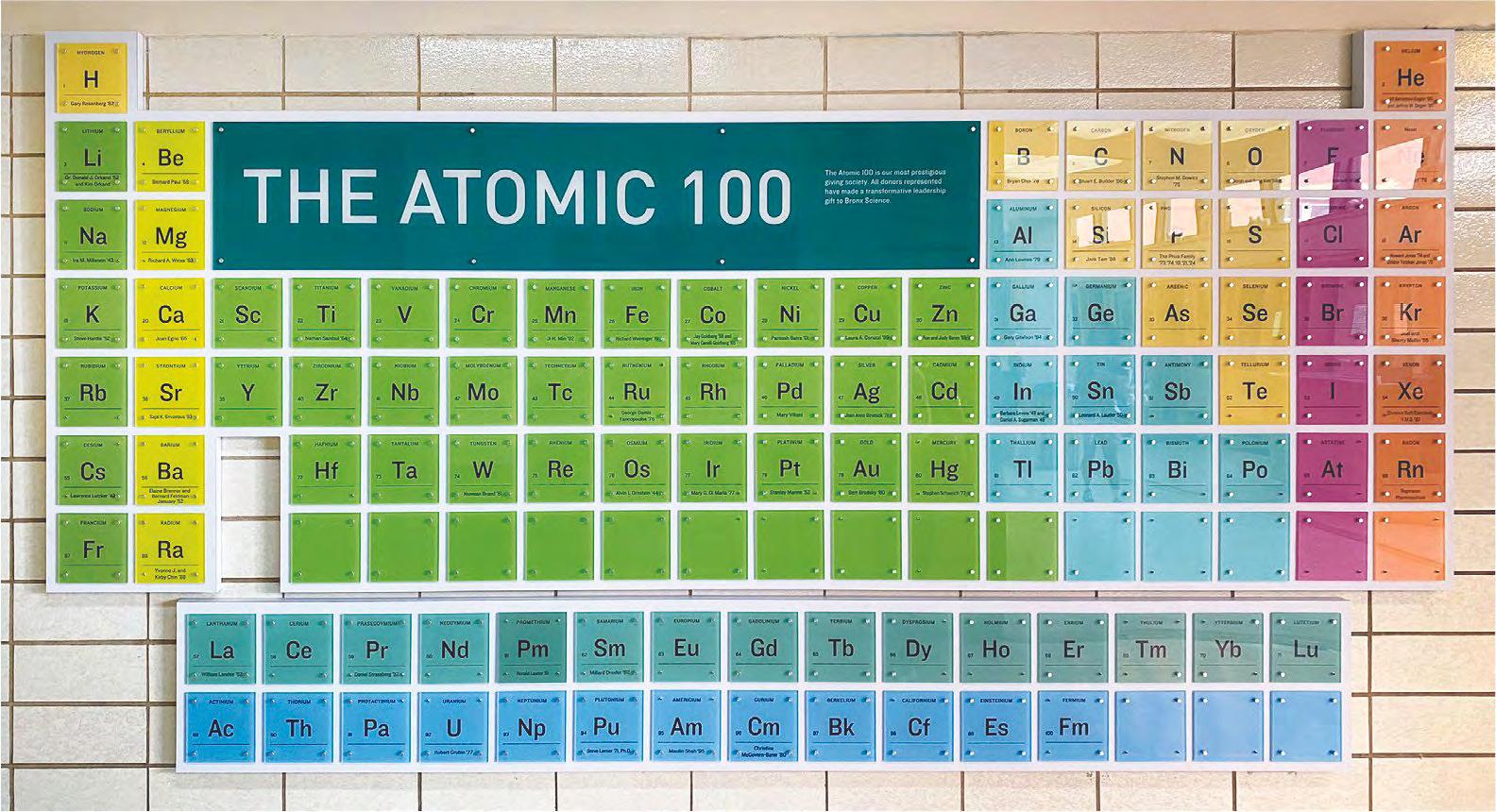
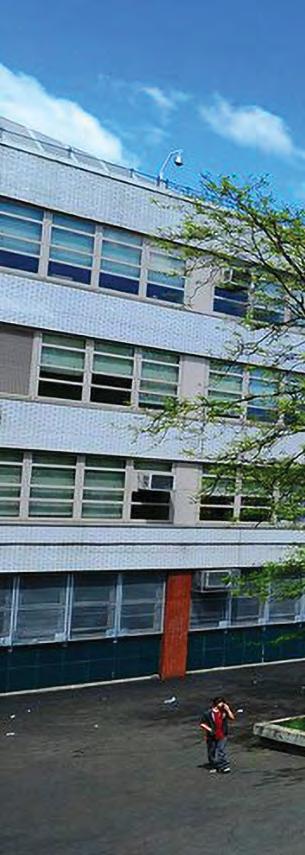
Our recently released 2023–2024 Annual Report provides a terrific overview of how Foundation gifts at every level were used last year to make a tangible impact on the educational experience of Bronx Science students today. We hope that you’ll check out this publication if you have not done so already.
As you will see, Foundation programming and funding touches every facet of the Bronx Science student experience, from academics to extracurriculars to the college search process. We are proud that our efforts for students continue to expand and evolve each year in response to both real-time needs of the school's strategic priorities for our student and alumni community.
This work of the Bronx Science Foundation can only continue with the help of gifts of time, talent and treasure provided by alumni and friends. Every member of our school community can play a role in our continued success—and we hope that you will consider yours today!
To learn more about any of the ways that you can make a difference at Bronx Science, please reach out to the Foundation team at foundation@bxscience.edu or 718.817.7800.
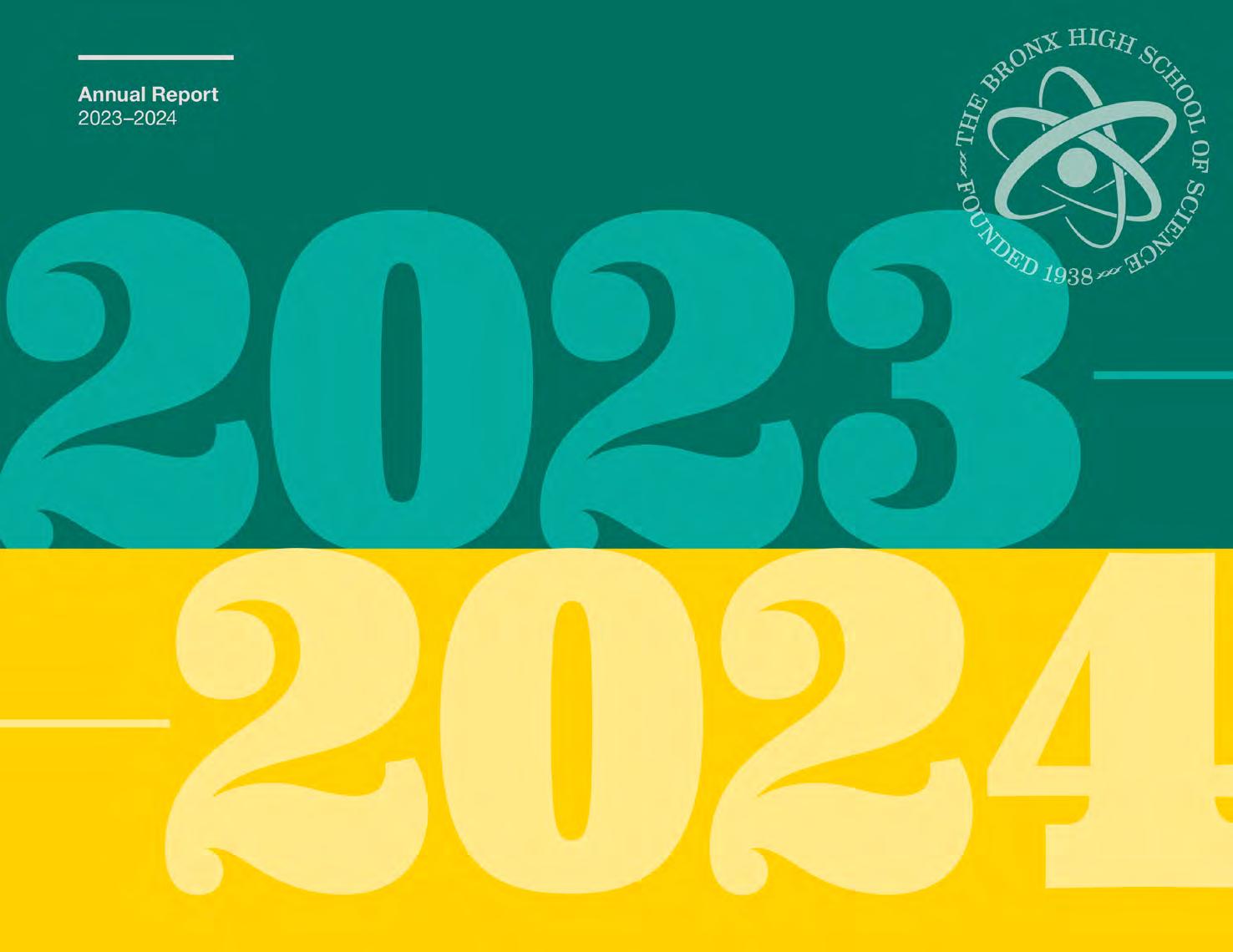
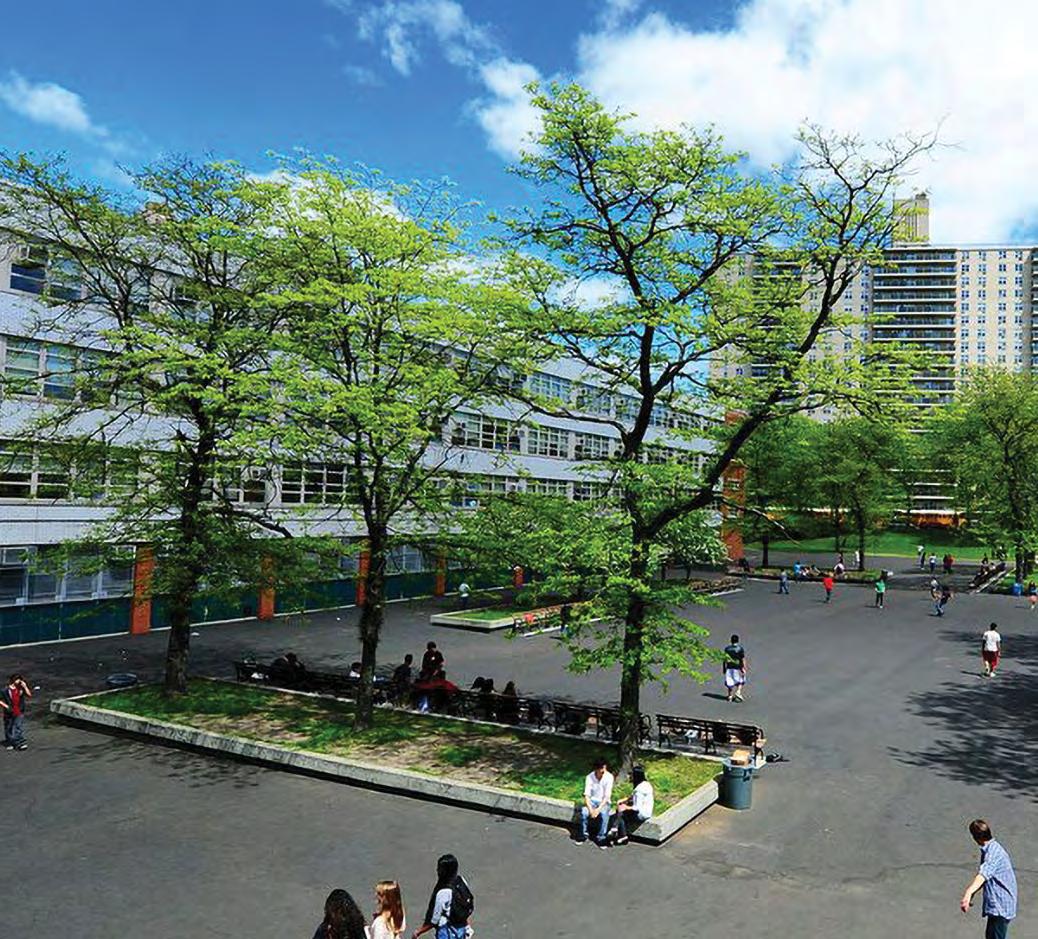
ARTICLE BY LIZA GREENBERG ’25
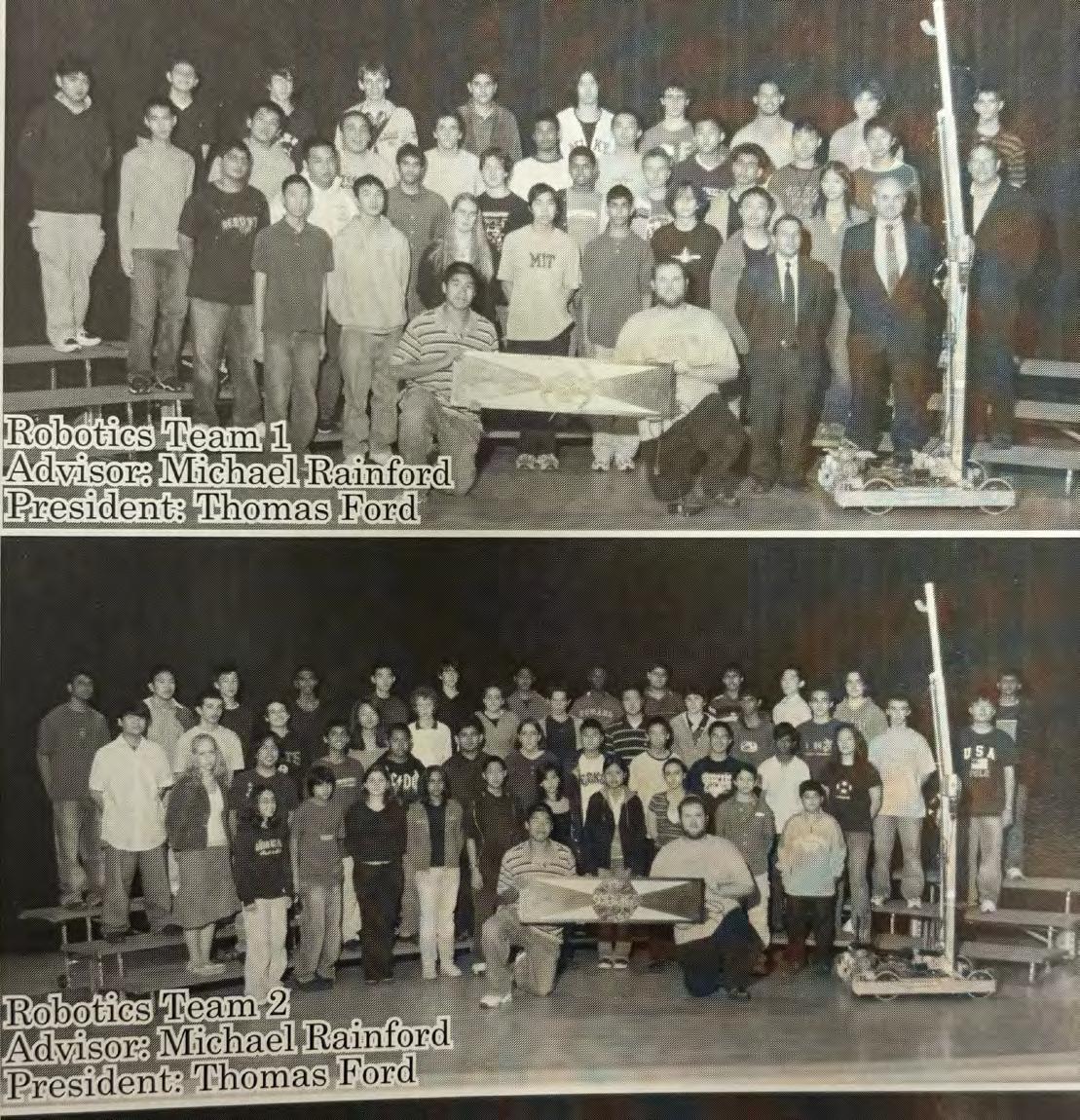
The 2005 Bronx Science Robotics Teams
In 2005, the self-driving car passed its first major test, the autonomous robotic vacuum cleaner hit the market, and, in the Bronx Science gymnasium, the Sciborgs debuted their first LEGO robot. No one then could have predicted how the SciBorgs would come to be a staple of the Bronx Science community, a force of innovation, community, and drive. When the FeMaidens followed two years later, they would create an equally powerful legacy—not only as a top-tier team, but as an inspiration to girls who want to take on the male-dominated tech world.
The history of both teams are far more than a collection of wins, losses, and robots; it's the story of a community that builds and rebuilds, not just from wires and circuits, but from sweat, enthusiasm, and zest for the activity.
The Sciborgs, the Bronx Science co-ed robotics team, initially started with building LEGO robots. In 2006, they were tasked with building a robot that would succeed in simulated underwater conditions. The same year, the FeMaidens was founded in response to the growing need for female representation in robotics. While the SciBorgs had made their mark, there was a quiet undercurrent of frustration among the female members—many of them felt that they were relegated to the marketing and logistical side of the team instead of designing and programming the robots themselves.
But any hostility between the teams has faded in the nearly 20 years of joint history. Ashley Lau ’15, former captain of the FeMaidens, recalls a specific moment when the teams seemed to come together. In 2015, after a season of rivalry and disagreement, the Sciborgs and FeMaidens were matched against each other at the Regionals competition. “The captain of the Iron Maidens and the captain of the Sciborgs walked out on the field, from opposite ends, and gave each other a handshake. They buried the hatchet right there on the field, which was pretty sick,” she said. “I can't remember who won the match.”
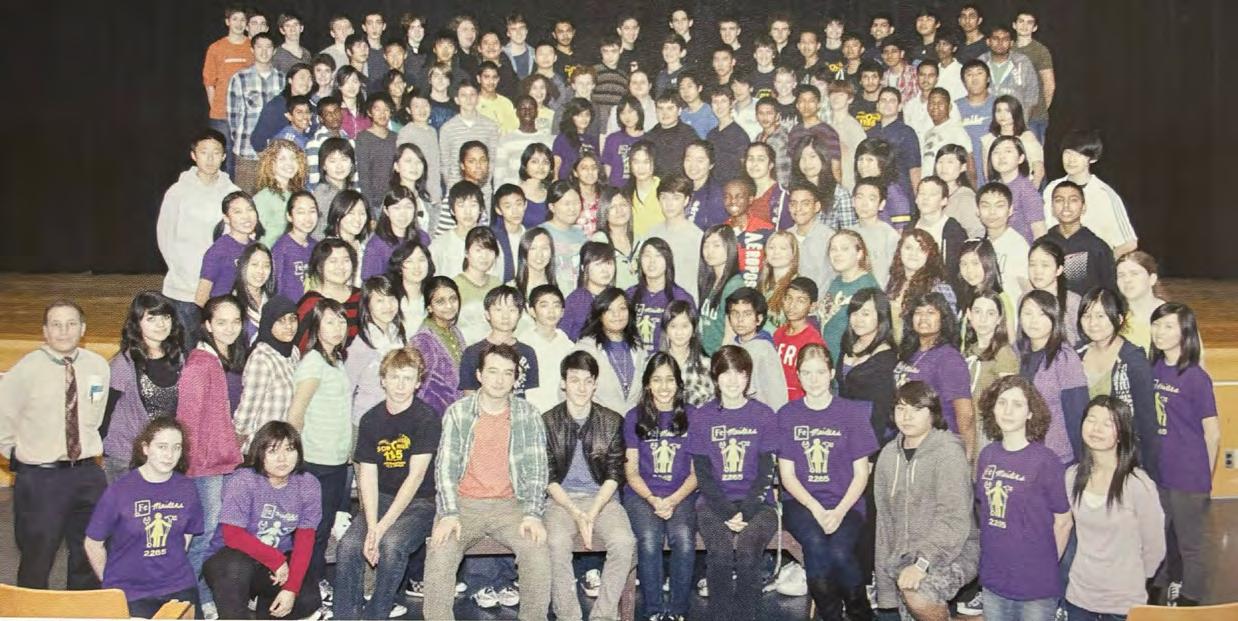
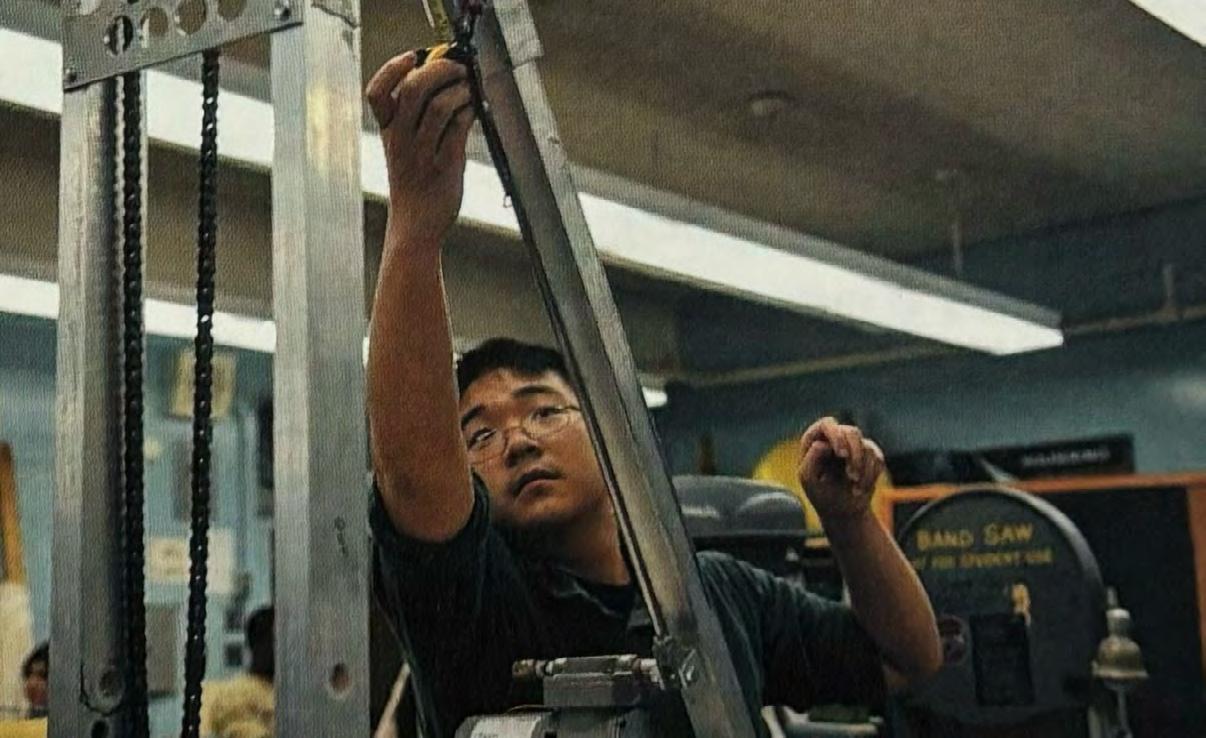
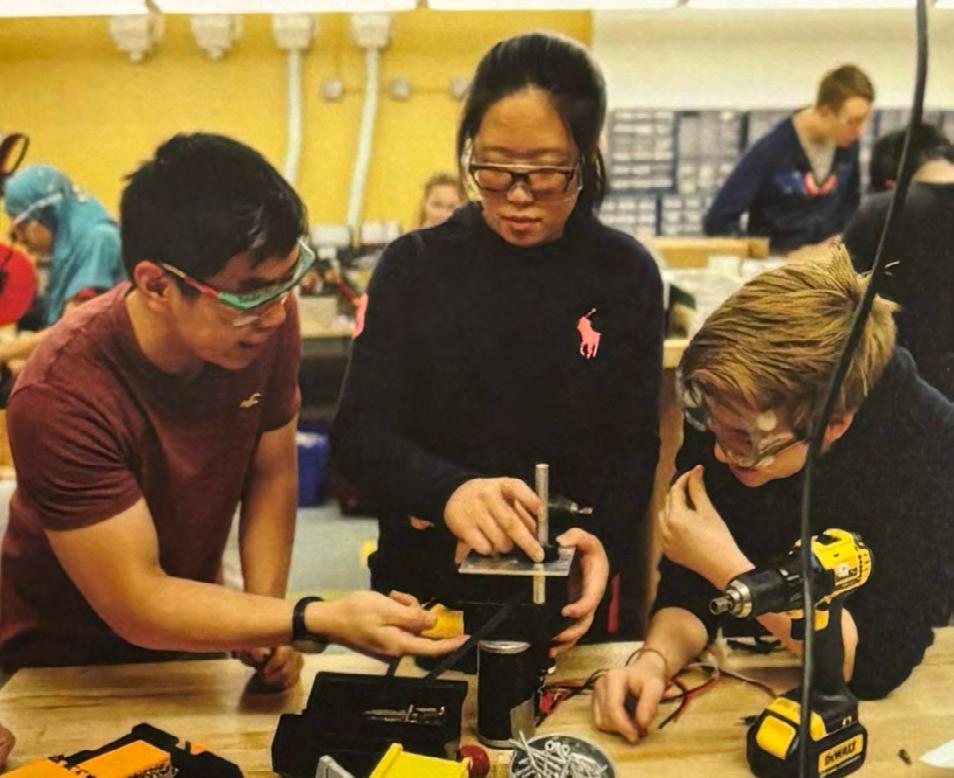
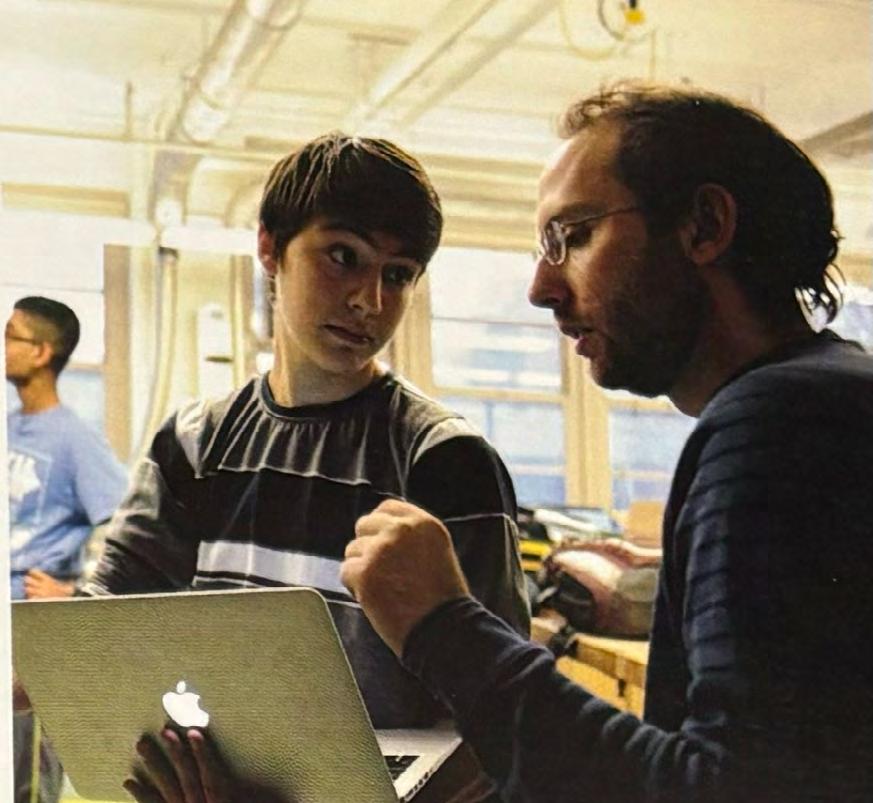
While the two are distinct teams, they work together closely, learning from each other, sharing equipment, and rotating space. Arun Bishop ’16, former captain of the Sciborgs, said, “It's a great experience, having an all-women team and a co-ed team that was started partially due to this friction and male domination in robotics. I think it forces a lot of the high schoolers to acknowledge gender issues at that age.”
By the early 2010s, the teams transitioned from LEGOs to more advanced robotics and began entering the international robotics competition FIRST (For the Inspiration and Recognition of Science and Technology). Since then, both the Sciborgs and the FeMaidens have constructed robots annually and succeeded through the ranks of the competition.
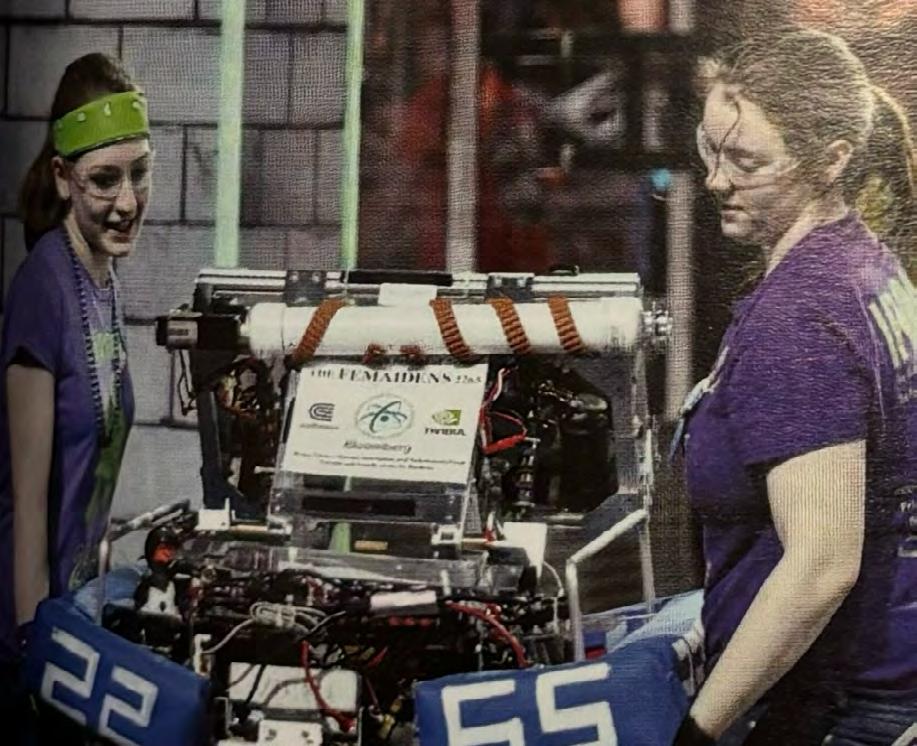
But building a robot is no easy task. Initially, the Sciborgs and FeMaidens had little to work with. The FIRST competition has many components, and both teams have had to structure their leadership to encompass engineering, programming, electronics, and marketing the team to sponsors. Understandably, it took time to build a large, well-oiled operation, in both the robot and the team.
From 2012–2016, the teams did some internal restructuring to take their work to the next level.
“I think I and a couple others really started to try to push to think more year to year, instead of just focusing on the current year,” said Bishop. Bronx Science also renovated the robotics shops in the basement and updated the aging equipment. At the same time, students started to take advantage of the overwhelming math, engineering, and technology resources and knowledge from teachers. According to Bishop, the team began to integrate physics and computer-aided design into their construction more seriously, which made all the difference in getting the Sciborgs to the FIRST quarterfinals in 2016.
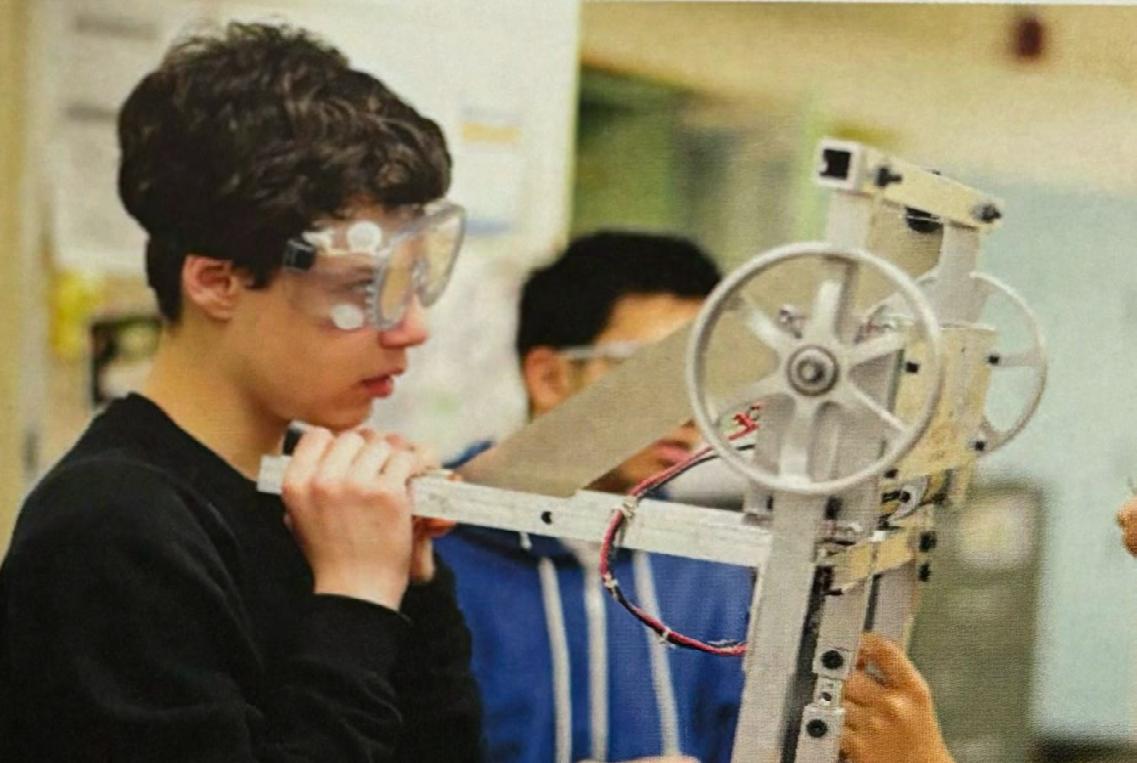
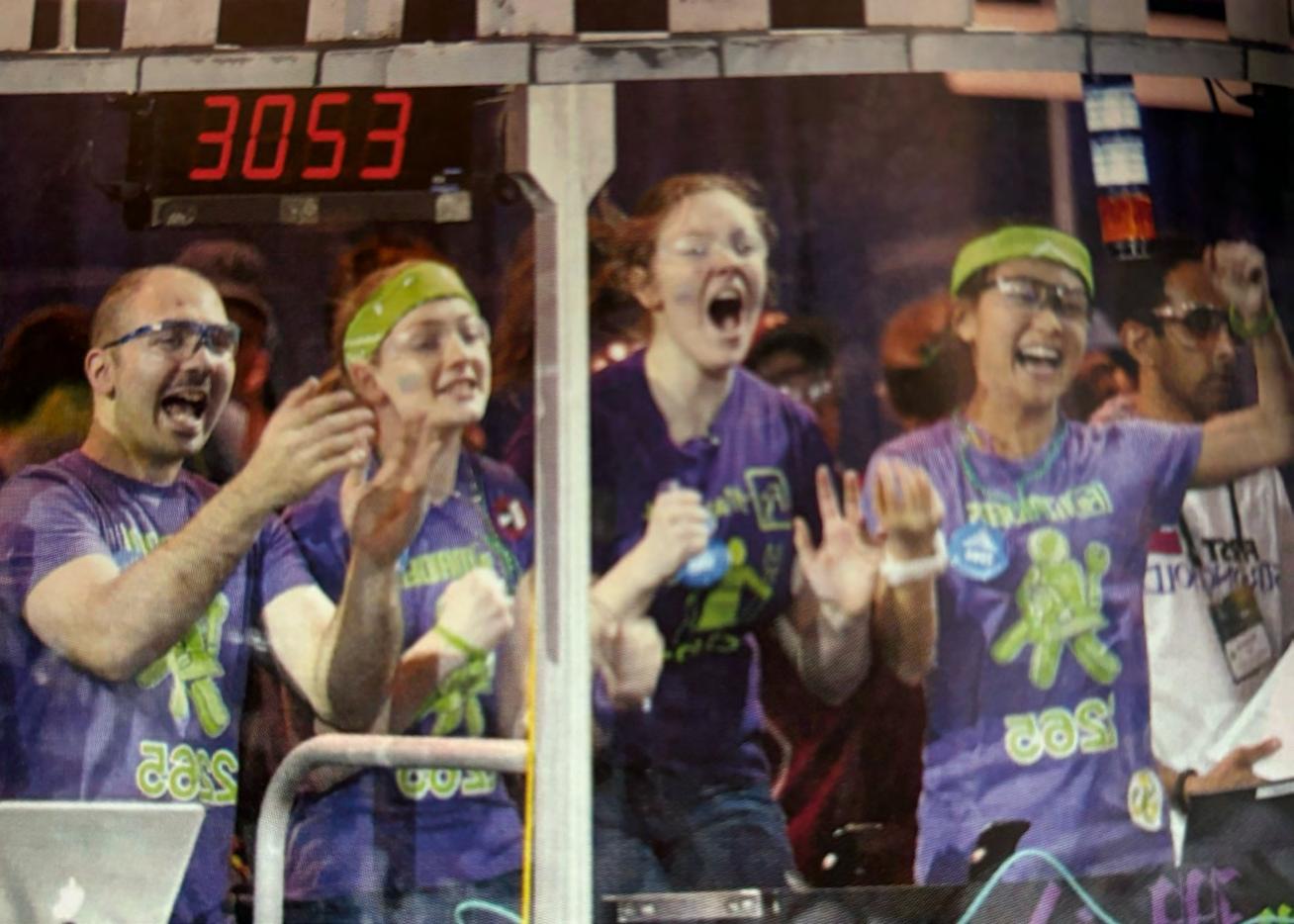
The FeMaidens excelled in the same period, drawing national media attention. A piece in Forbes titled “Don't Tell This Robotics Team That STEM Is For Boys” showcased the student leaders of the FeMaidens and a documentary crew from Independent Lens came to the Bronx Science shop and the FIRST competition to follow their season. In the article, a student member of the FeMaidens was asked about the team name and explained the team's founding captain was a fan of the heavy metal girl band Iron Maidens. "We're a group of girls, we're tough as iron,

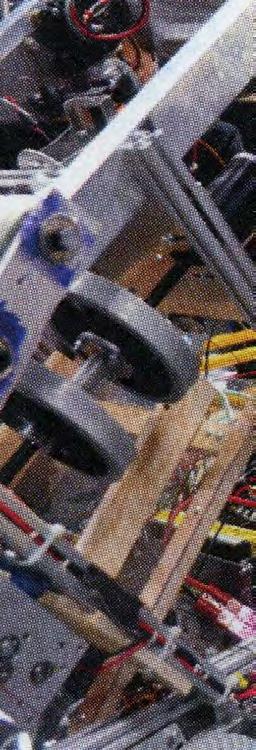
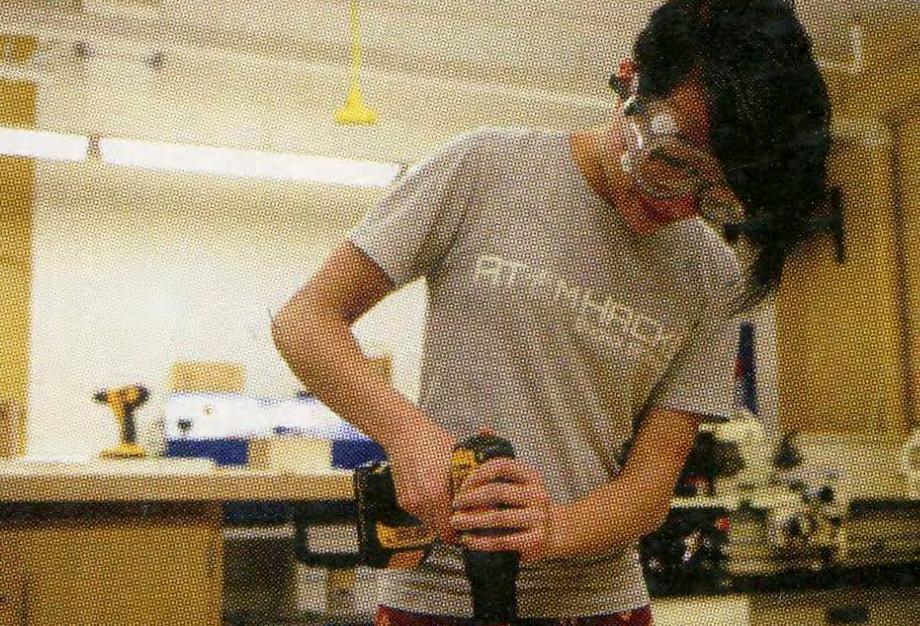
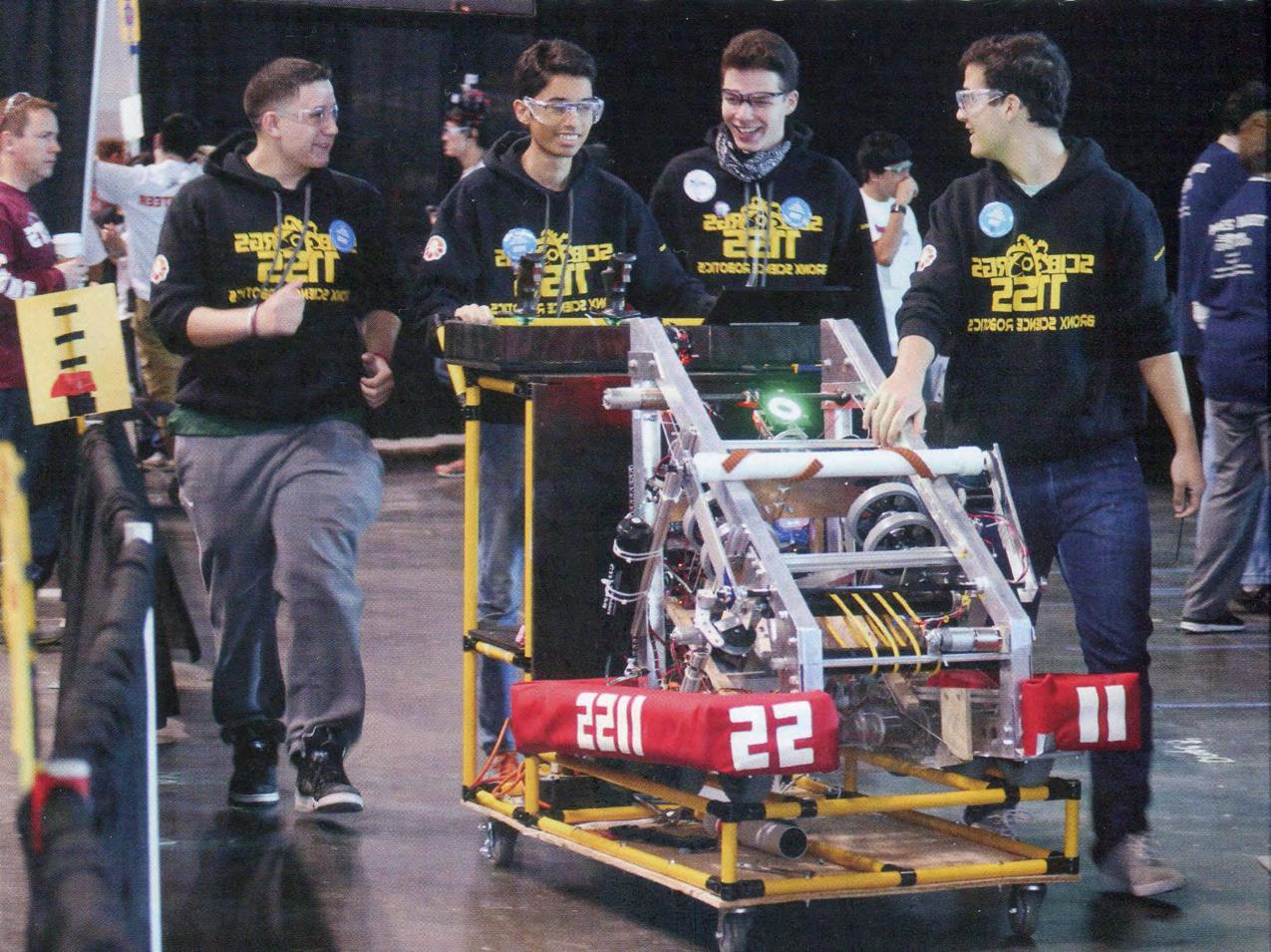
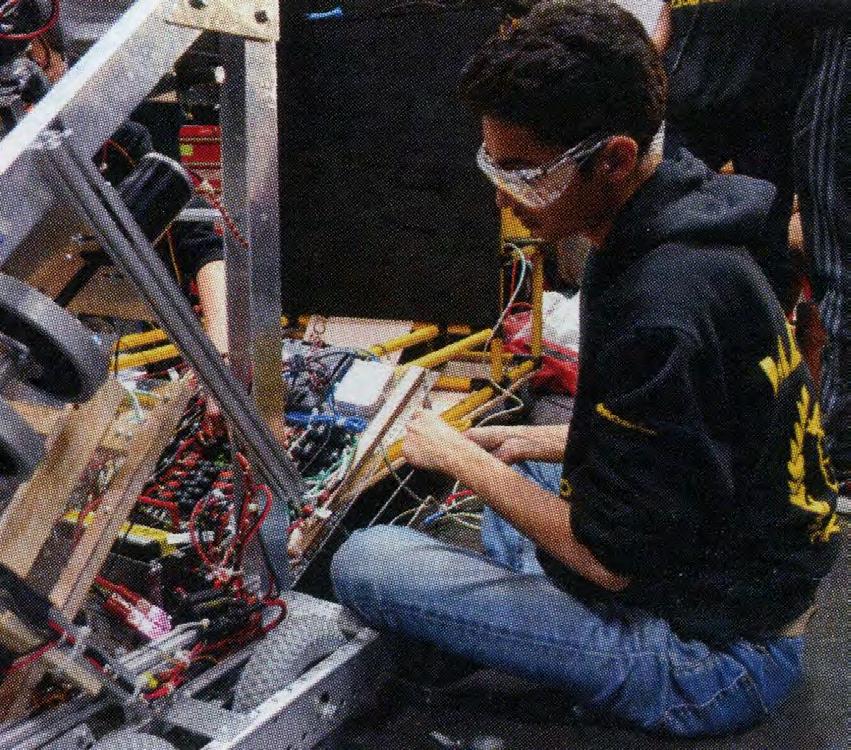
we're building what the guys are building, so we just went with it,” said Luz Jimenez ’16 to Forbes.
Both teams also started placing a growing emphasis on their work beyond the competition, creating initiatives to teach local middle schoolers the basics of robotics, including with LEGOs. As a whole, their initiatives were meant to show young students the paths in STEM that they could pursue.
Much of the work former captains poured into the teams has had lasting benefits. Student leaders continue to place an emphasis on recruitment, team bonding, and passing down knowledge to cultivate the next generation. “I came back, I think, two years ago, and I was really impressed by their capabilities and how much they seem to know,” said Bishop. “It was very different when I first joined,” Bishop said.
To this day, Lau follows the team on Instagram and stays updated on their current activities. She credits the FeMaidens and their emphasis on community service and making robotics accessible as the reason she has, while pursuing both a Bachelor’s and Master’s in mechanical engineering at Stanford, continued to mentor local robotics teams. “You can gain as much from it as they can,” she said. “It's both inspiring and enlightening, almost, to see how they approach challenges in the world… If you can give that opportunity to anybody, it's like you're guaranteeing growth for all these people, both as the giver and as the receiver. And so I say, you know, support the team.”
Bishop, now earning his PhD in robotics from Carnegie Mellon, said, “keeping the team strong, keeping those opportunities to explore your passions, learn leadership, get experience, and really getting a step up is practically priceless.”
ARTICLE BY ISABEL GOLDFARB ’25
The Bronx Science Sciborgs and FeMaidens have officially kicked off their 2025 build season for the FIRST Robotics Competition (FRC), where this year’s game, Reefscape, promises to test their skills and creativity. In this underwater-inspired pick-and-place game, robots must carefully transport coral into designated reefs while relocating algae to specific areas on the playing field. With build season in full swing, both the FeMaidens and Sciborgs are hard at work designing and assembling a robot that can
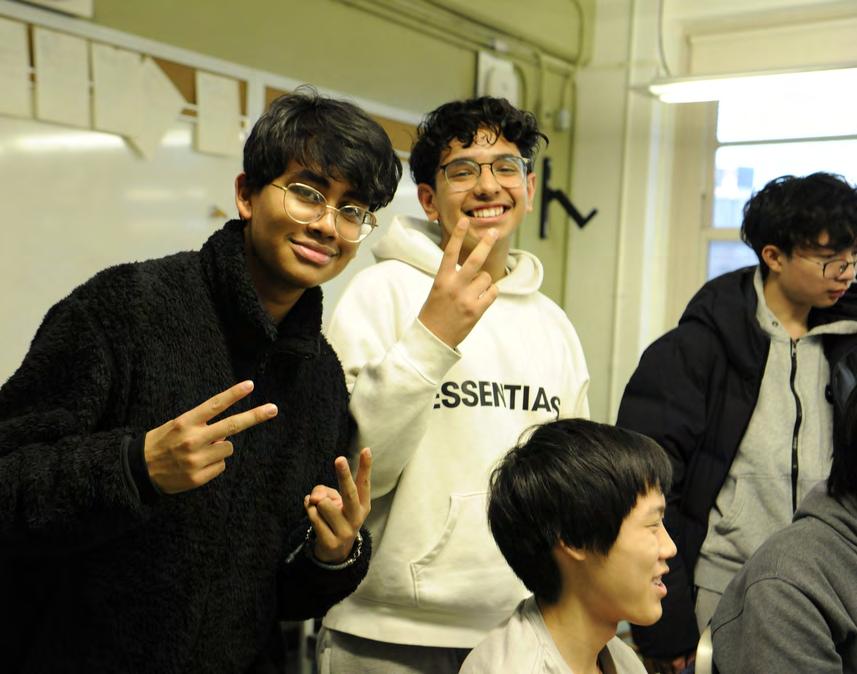
“This game demands a lot of precision,” said Parthiv Patel ’25, Head of Electronics for the Sciborgs. “We’re designing systems that can handle complex movements and place game pieces accurately, all while optimizing for speed and efficiency. It’s a tough balance, but that’s what makes it so exciting.”
Last season, the Sciborgs achieved impressive results in Crescendo, the 2024 FRC game centered on a music and concert theme. In this competition, robots scored foam rings—called "Notes"—into amps and speakers, and climbed truss structures known as "Stages" during the endgame. At the Hudson Valley Regional, the Sciborgs ranked 11th out of 48 teams and were selected as the first pick for the 5th alliance, earning the Gracious Professionalism Award. Later, at the New York City Regional, they ranked 4th out of 51 teams, led the 4th-ranked alliance as captains, and advanced to the lower bracket finals, finishing 3rd overall.
The FeMaidens have also had a strong presence in the FRC competitions, proving their dedication and skill on the field. Last season, they were part of the winning alliance, securing first place and earning the Best Battlecry Award for their outstanding team spirit. Their impressive performance continued at the FIRST Robotics New York City Regional Competition, where they received the Imagery Award. This prestigious award celebrates attractiveness in engineering and outstanding visual aesthetic integration from the machine to the team appearance.
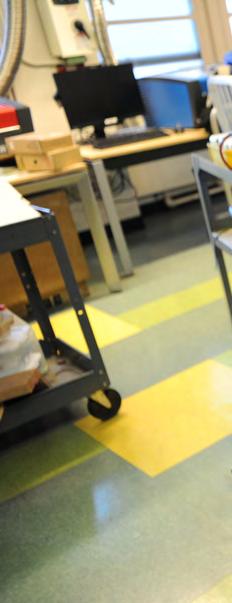
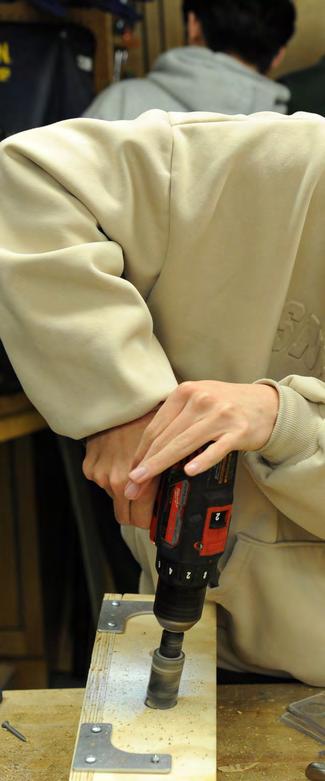
Reflecting on these achievements, Diana Ryu ’25, Captain of the FeMaidens, noted, “Last year’s success gave us a lot of momentum going into Reefscape. We’re building on what worked, while also innovating in areas we know we can improve.”
This year’s robot design features cutting-edge technology and meticulous planning. The Sciborgs and the FeMaidens are developing a shooter systems, equipped with eight horizontal stealth wheels powered by NEO Vortex motors; an arm mechanism, a custom gearbox with a 98:1 gear ratio powered by four NEO motors allows for controlled and accurate placement of game pieces; and a UTB Intake.
“Every component of the robot is designed with this year’s unique challenge in mind,” Parthiv explained.
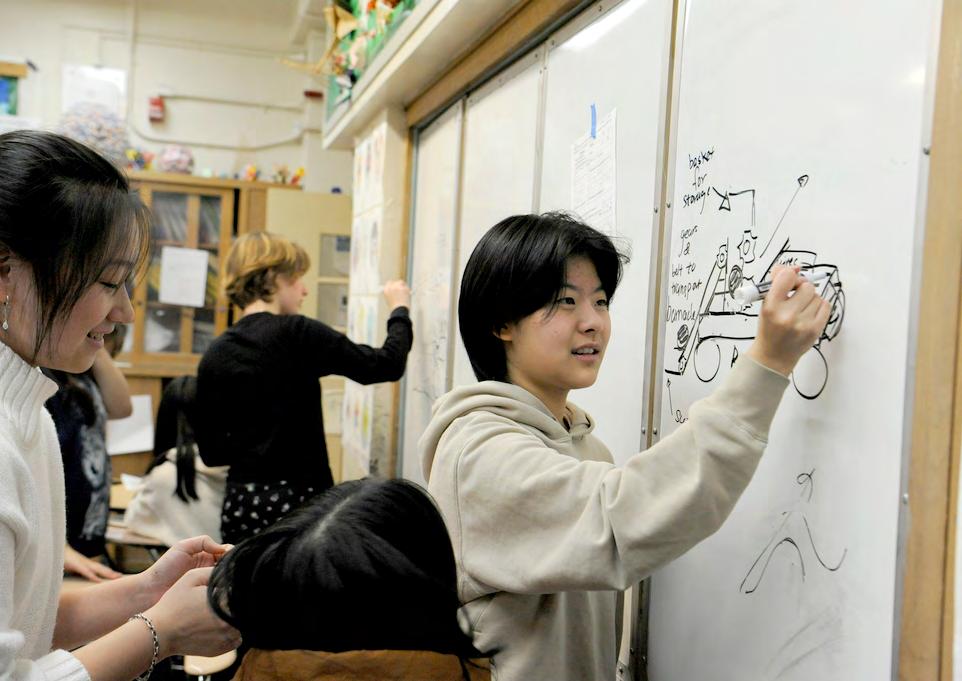
“We’ve learned a lot from prototyping, and our team is confident this design will perform well on the field.”
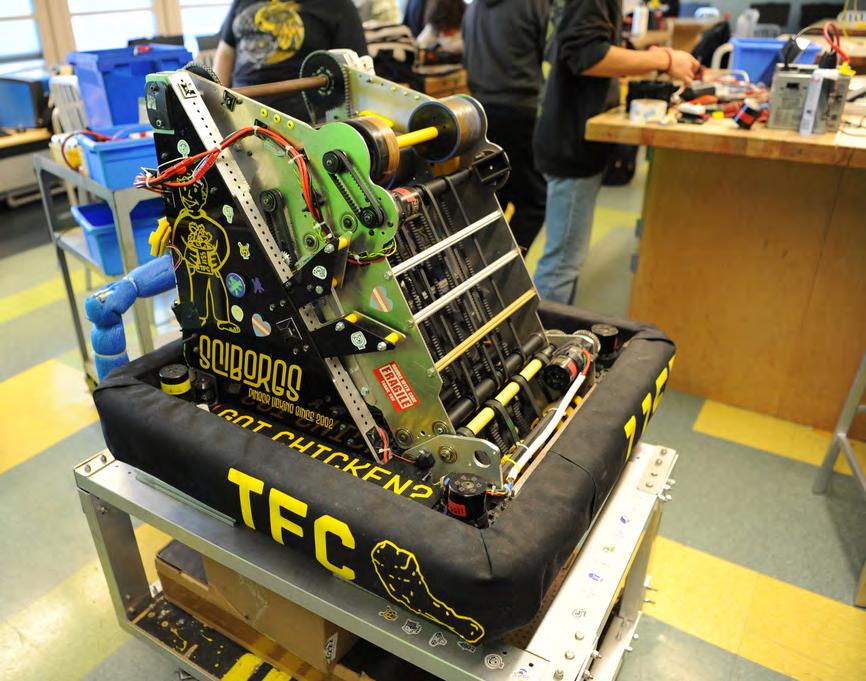
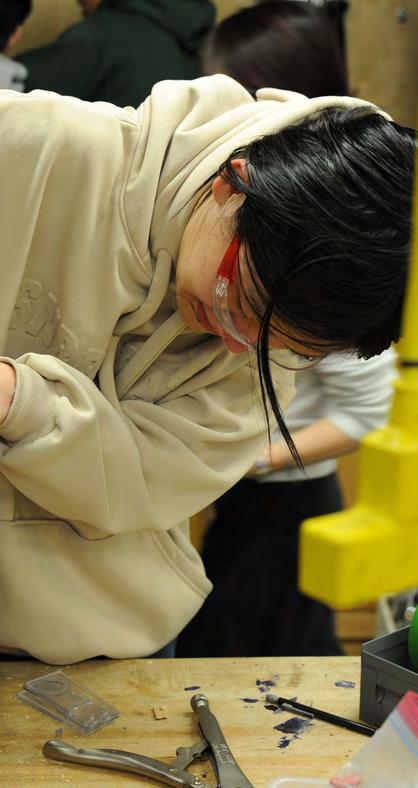
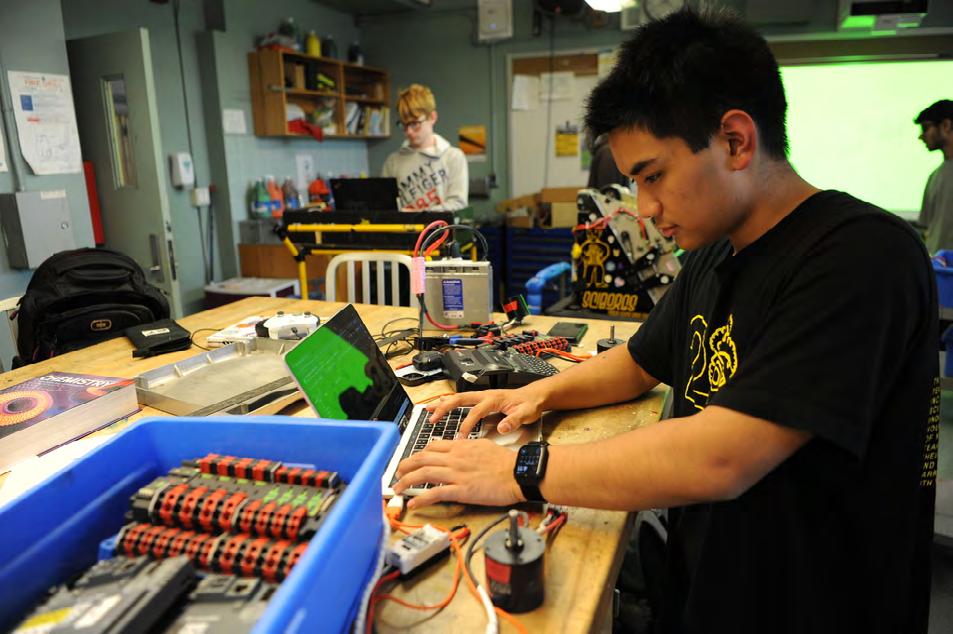
Both the Sciborgs and FeMaidens are fortunate to have access to top-tier resources, thanks in large part to alumni donations and support. Their well-equipped workspace includes advanced tools, parts, and software essential for bringing their ambitious designs to life. “We couldn’t achieve what we do without the generous contributions of our alumni network,” Diana added. “It’s a huge motivator to know that former Sciborgs believe in our work and want to see us succeed.”
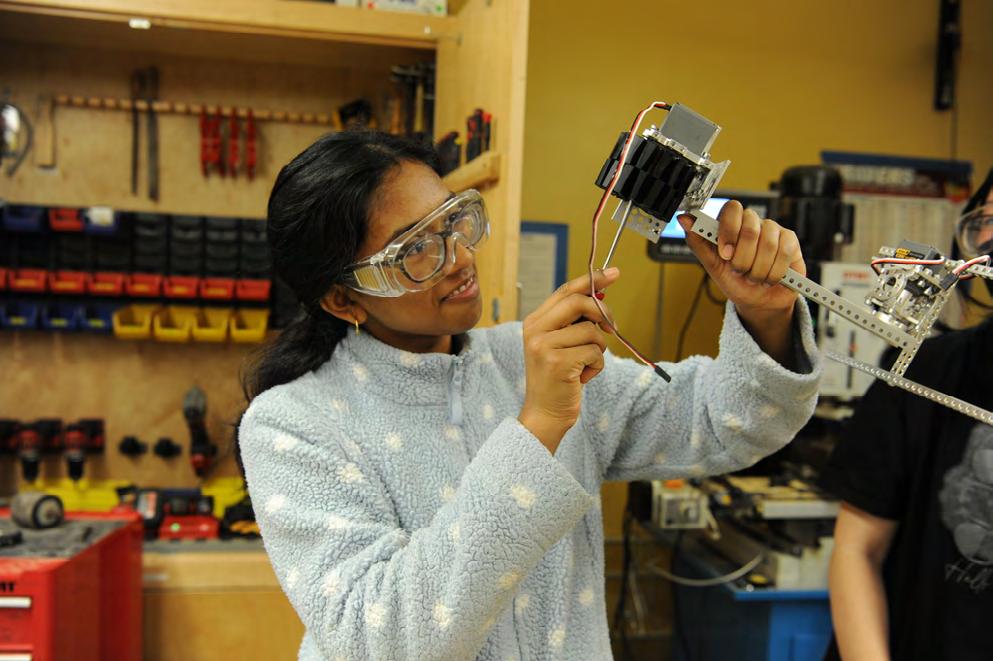
As the build season progresses, the Sciborgs and FeMaidens are focused on refining their design, conducting rigorous testing, and preparing for regional competitions. With a track record of success and a team full of dedicated students, they’re poised to make waves in the 2025 Reefscape game.
ARTICLE BY ANNA KOONTZ ’25
“The best writers learn to look under the hood”: studying other people’s work, analyzing the inner framework, and taking inspiration. Robert Samuels ’02 discovered this technique long before he became a Pulitzer Prize winning author and journalist. As a high schooler, he modeled a jingle for chemistry class after the opening lines of “Trees” by Joyce Kilmer.
I think that I will never see
A number as big as 6.02 times 10 to the 23
It’s called a mole in chemistry
How did they name it that? Don’t ask me
Unsurprisingly, chemistry and poetry were Samuels’ favorite subjects at Bronx Science. Outside of class, his greatest joy was competing on the Speech & Debate team.
Samuels used to stare in awe at the giant Speech & Debate trophy case each time he visited Bronx Science for his older sister’s basketball games. When he enrolled at the school a few years later, he immediately joined the team and quickly rose in leadership. His responsibilities included cleaning the trophy case. “It was one of the worst duties to do as president, but to me it was the highest honor,” he joked.
Mr. Richard Sodikow ’55 was the Speech & Debate director at the time. Samuels
remembered Mr. Sodikow’s powerful voice – “a mix of Shakespeare and growing up in the North Bronx” –and transformative influence on his life. Mr. Sodikow sponsored a trip to run workshops in the Northern Mariana Islands, helped pay for Samuels’ flight to an international tournament in South Africa, and continued to stay in touch after Samuels graduated.
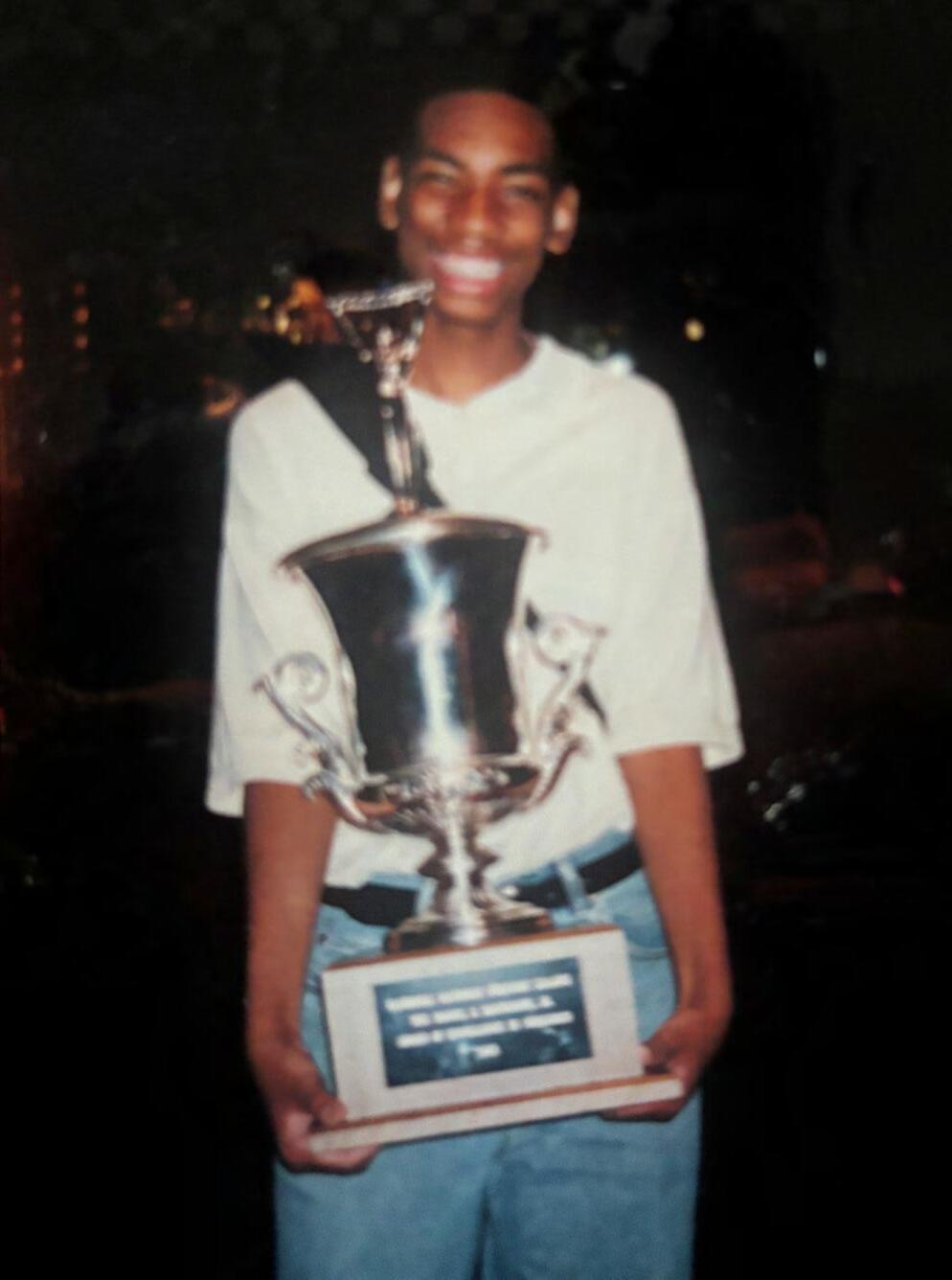

Samuels next attended Northwestern University. He had fallen in love with the university’s location and culture, but his parents felt unsure about a college so far away. Samuels convinced them by insisting that he wanted to study at Northwestern’s top-ranked Medill School of Journalism. This was “kind of true, but mostly a ruse,” he admitted.
However, Samuels soon recognized that journalism was the perfect outlet for his fascination with the world’s diverse places, people, and perspectives.
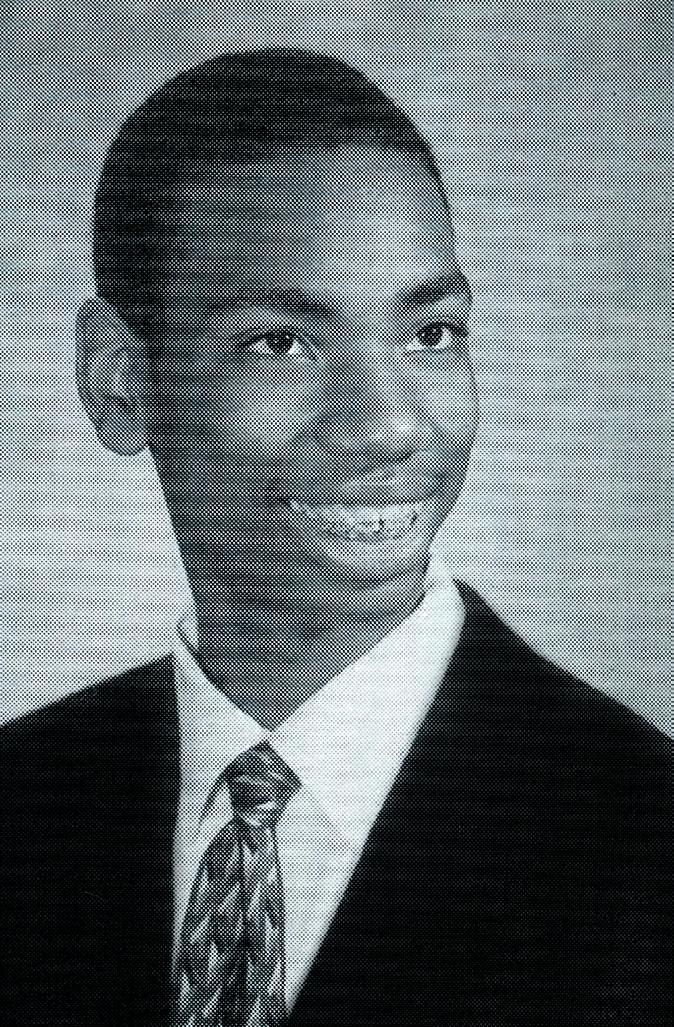
Interacting with students from many different backgrounds at debate tournaments had ignited a “sense of wanderlust” and an “insatiable love for learning.” He explored these interests as the Editor-in-Chief of two student publications, The Daily Northwestern and BlackBoard.
Samuels continued to gain valuable experience through internships with media companies such as Fox News and the Washington Post. After earning his journalism degree, he worked at the Miami Herald for five years and then returned to the Washington Post in 2011 as a staff reporter. He also briefly worked for the New Yorker.
Throughout his career, Samuels has written hundreds of articles examining politics, race, and occasionally, figure skating. “Why did so many people fall in love with the Trump presidency? Why are we so divided?” he wondered aloud. He traveled across the country in search of answers, recording people’s stories and sharing their insights with the world.
In 2020, Samuels collaborated with Toluse Olorunnipa and a few other Washington Post reporters on the six-part series “George Floyd’s America.” Each article connected a different stage of Floyd’s life to broader topics such as education, housing, or the prison system. But Samuels and Olorunnipa wanted to do more. They envisioned expanding the series into a 400page biography titled His Name is George Floyd.
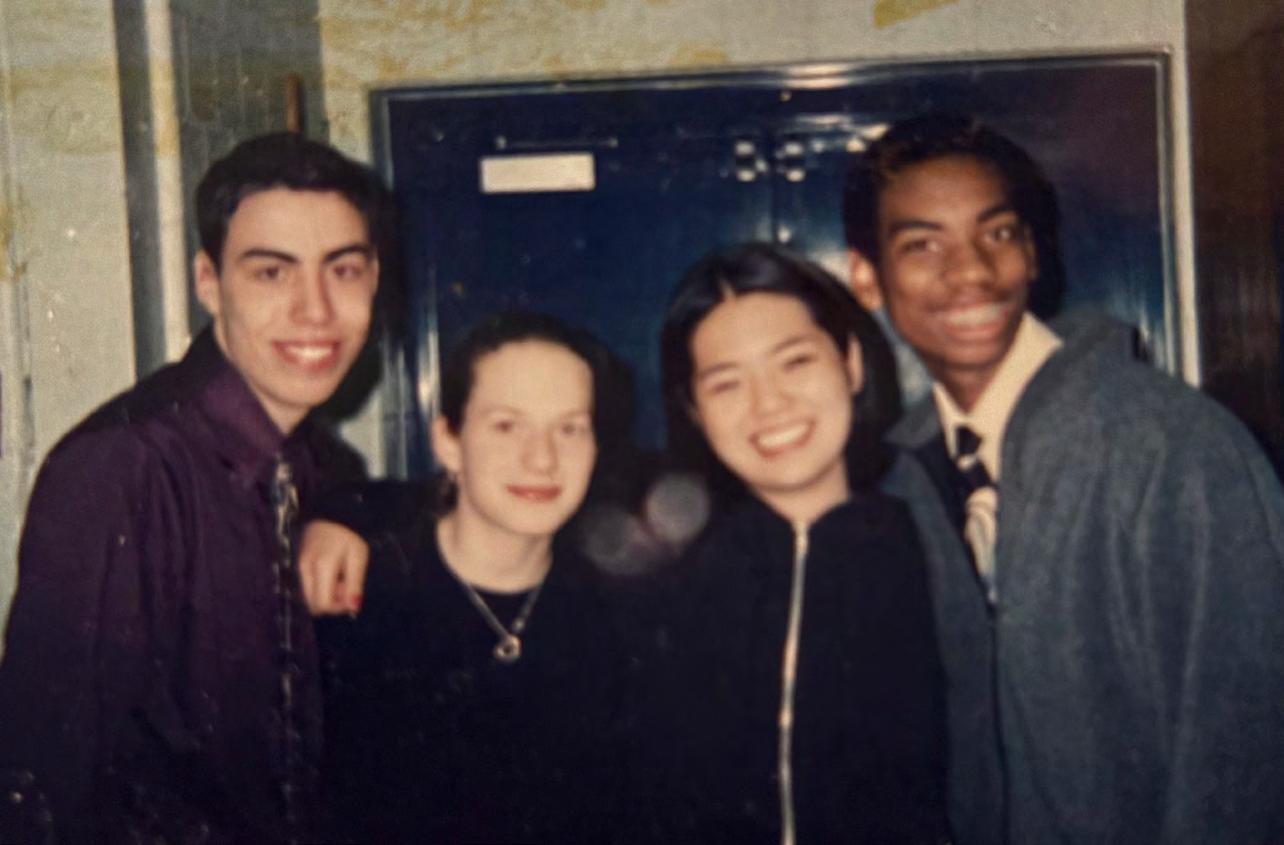
Samuels and Olorunnipa looked under the hood.
They studied George Floyd’s life through conversations with loved ones in his old neighborhoods. They analyzed the inner framework of systemic racism by tracing both Floyd’s and Derek Chauvin’s family history. They took inspiration from the backlash to Floyd’s
death and the global Black Lives Matter movement to articulate a powerful plea for racial justice.
Interviews with Floyd’s acquaintances and neighbors led to interviews with close friends and family members, then the governor of Minnesota, then the president of the United States. Most research projects of this scale would take at least six years, Samuels noted, but “we probably did about 400 interviews in about six months.” They raced to finish the book before public attention drifted.
As Samuels welded wide-ranging emotions and memories into a narrative, he wondered how to best structure climactic chapters. Instead of turning to Kilmer as he had in high school, Samuels now studied Fitzgerald. Floyd’s biography, like The Great Gatsby, would hinge on a violent murder. Samuels wanted to understand how to craft a memorable ending that spoke to both the book’s narrative and larger themes.
Samuels and Olorunnipa published His Name is George Floyd in May of 2022. Rave reviews filled the internet and fans at book fairs crowded for signatures. One reader, overcome by emotion, told Samuels that it was the most impactful book she had read in 25 years.
“As a writer, it’s humbling and fascinating to know that your work could be that intriguing to people,” said Samuels. “But also as a person who lives in this country, who has dreamed of it being a better place for my friends’ kids and eventually my kid, it is such a warm, encouraging feeling to know that you put something in the world that can help people understand the nature of how racism works.”

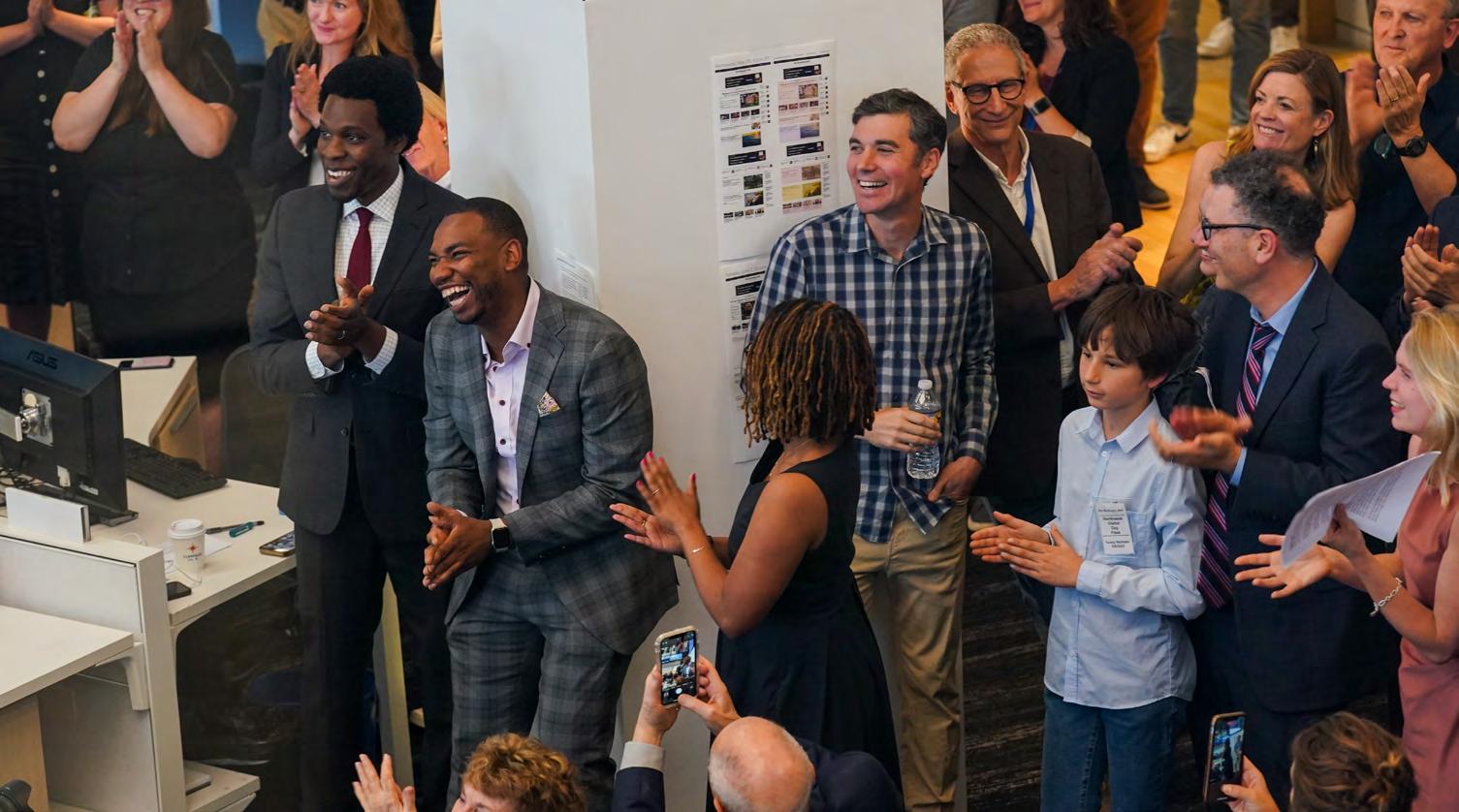
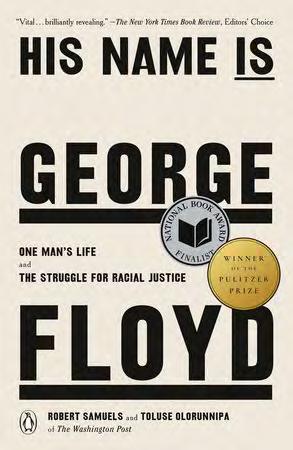
In November, the National Book Foundation honored Samuels and Olorunnipa as finalists for the 2022 National Book Award in Nonfiction. A few months later, Samuels was in the bathroom when he received an unexpected phone call. “My spouse comes upstairs, and she sees me with my pants down on the phone, and she’s like, ‘What happened?’ And I yell to her, ‘We won!’” His Name is George Floyd had received the 2023 Pulitzer Prize in General Nonfiction.
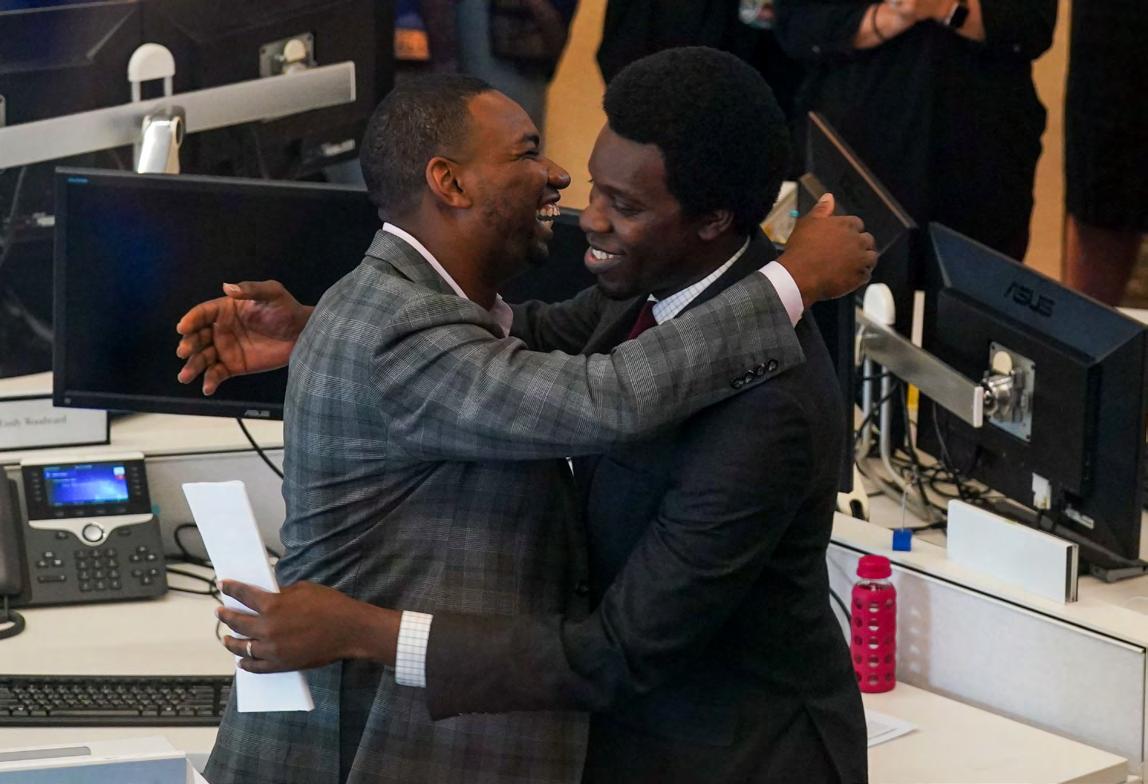
During the public announcement, Samuels’ phone exploded with congratulatory texts from family members, friends, and old high school classmates. Sitting with his parents later, Samuels’ father expressed how he wished they could also celebrate with Mr. Sodikow, who had passed away. “We had this really crazy moment where we just cried. He would have been so thrilled and so proud to have known that one of his debate kids got the award.”

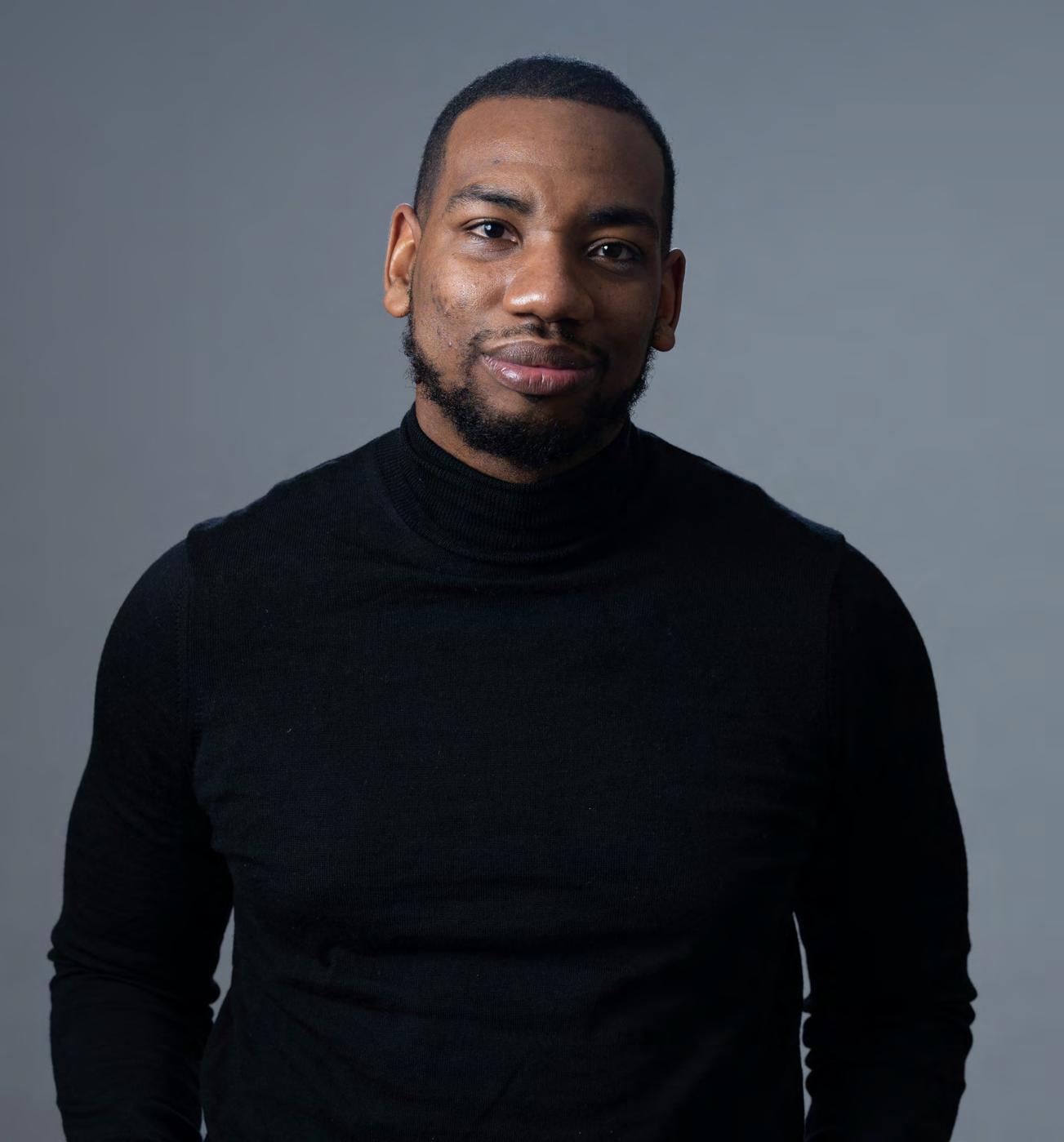
Samuels recognized the lasting influence of Bronx Science’s supportive teachers as well as its educational environment. Although he doesn’t remember all of the poems he studied or each element in the periodic table, Samuels continues to live out the school’s approach to learning.
“Be skeptical. Interrogate every thought, come to the best conclusion. And when you get to the best conclusion, do something about it,” Samuels remembered internalizing. “Having knowledge is not the end game. Being able to capitalize on that knowledge, to create a new discovery and make the world better: that is the actual end game.”
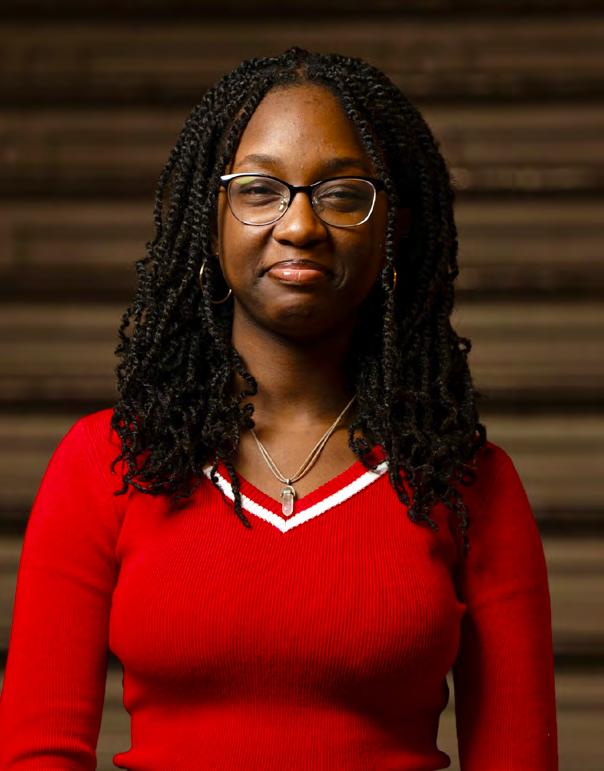
BY AVIV KOTOK 25
Born and raised in the Bronx, Jadyn Sinclair ’25 stands out as a leader and advocate in her school and community.
Her time at Bronx Science has been marked by resilience and personal growth, including her choice to attend: she passed up significant scholarships for Catholic schools to come to Bronx Science.
Besides excelling in the classroom—her favorite course is AP Biology—Jadyn has made a significant impact through various extracurricular activities, such as being elected Vice President and now President of Student Government. “I wanted to bring a fresh perspective to the table as a minority student and ensure that my voice, along with the voices of my peers, was included in discussions that often happened behind closed doors.”
Jadyn also co-founded the BSU Black and Latinx Mentorship Program. “The program was born out of my personal experiences and recognition of the deep, systemic challenges that minority students often face in a specialized high school environment—a place that…can sometimes feel isolating for students who don’t see their experiences reflected in the broader school culture or population. The mentorship program aims to bridge that divide by pairing upperclassmen with younger students from Black and Latinx communities to offer guidance, support, and a sense of belonging.”
She also serves on the Superintendent and Chancellor’s Student Advisory Councils, where she advocates for student needs and educational reform, and volunteers at Mount Sinai Morningside Hospital. “I’m passionate about ensuring that all voices, especially those of underrepresented groups, are heard,” she said, reflecting on the learnings of empathy and connection she’s had in these roles.
In the future, Jadyn aims to blend medicine with socio-cultural advocacy. “I envision myself as a doctor who travels to underserved communities.”
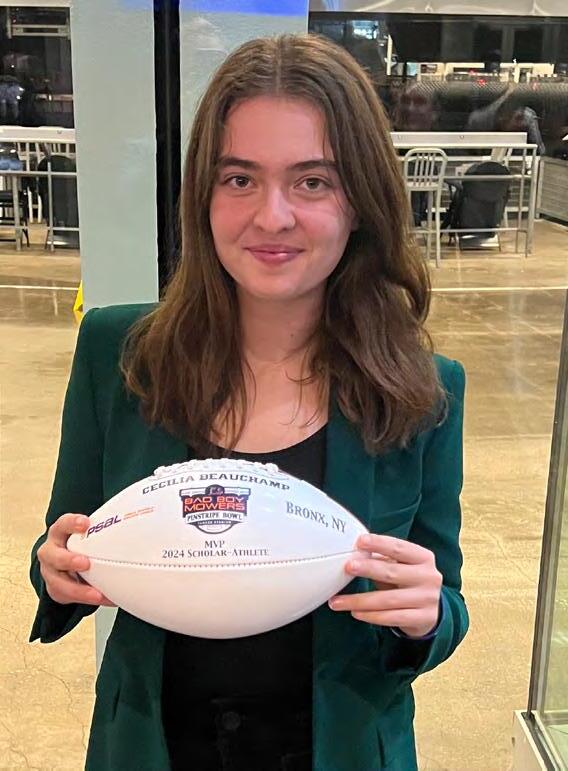
BY AVIV KOTOK ̓25
Cecilia “Cece”
Beauchamp credits growing up in Washington Heights, where she was surrounded by her heritage and a strong sense of community, as the motivator of her leadership. Her experience in leadership started as early as middle school. “When I was in eighth grade I became president of my middle school… I realized how fun it is to unite people and work to create a tighter community.”
At Bronx Science, Cece’s involvement has continued to shape the community. As Senior Council President, she is committed to strengthening the bond among her senior class. “I wanted to do my part to make sure we have an incredible senior year,” she says. She is most proud of organizing and planning the most recent Homecoming, and describes it as “truly a memorable experience.”
Cece’s leadership also extends to athletics. She captains three varsity sports—tennis, basketball, and flag football—and serves as
the Athletics Committee Director, where she oversees Bronx Science’s athletics Instagram page. Additionally, she plays rugby year-round outside of school and aspires to play at the collegiate level. She co-founded the Anti-bullying Committee (ABC) in hopes of making the school bullying-free. Through her work, she strives to help others find Bronx Science to be as a supportive environment as she does. “Through my years at Bronx science this school has given me so much,” she says.
Cece is eager to study higher sciences and math in college while continuing to engage in student government and sports.
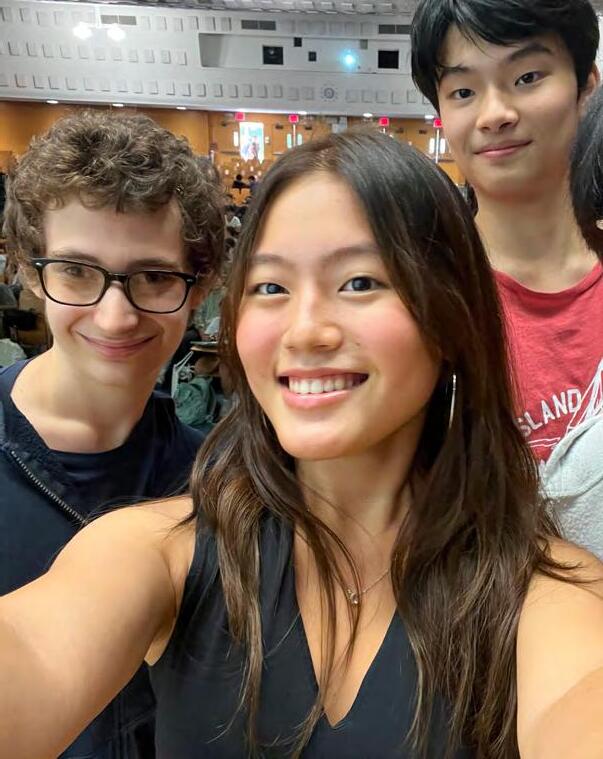
BY DARA KING ̓25
Growing up, Kayla Park ’25 first learned the virtue of community service from her parents when they would volunteer to hand out flowers to the elderly and people in long-term care facilities. Park has carried this virtue with her from California to NYC, and thankfully into Bronx Science. While running for President of the National Honor Society (NHS), Park knew that she was up for
Kayla Park continued
the task and was excited to be able to engage with NHS on a larger scale. Noticing the disconnect between the large community and leadership, Park has implemented more open dialogue. “While I am the president of NHS, I'm also a member who’s willing to connect with everyone and who also believes that volunteering is important.”
NHS provides many opportunities to network and make connections, but also gain a higher understanding of the importance of volunteering. Park hopes that NHS members get more than just volunteering hours; she also hopes that they form stronger connections with their communities and want to be more involved in benefitting them. Park herself has always lived in environments where Asians were a minority, leading her to found AAPI Youth, a nonprofit foundation dedicated to giving back to the Asian community and spreading awareness about Asian culture through the youth. “There are so many amazing experiences you can have with your identity, ethnicity, and the memories of your own community and I just want more people to be able to experience and share in that.”
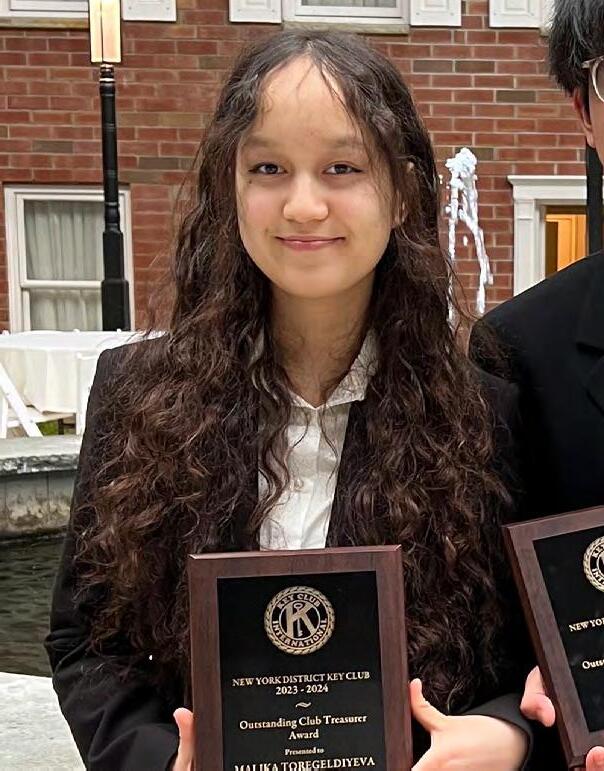
BY DARA KING ̓25
Community service helped Malika Toregeldiyeva ’25 find her voice. Immigrating in her childhood, Toregeldiyeva felt as if she didn’t get the chance to connect with the community around her - until joining Key Club her freshman year at Bronx Science changed this. Attending volunteering events all over the city not only allowed Toregeldiyeva to learn more about the diverse communities around her, but helped her to branch out, develop her public speaking skills and join a community of her own.
As President of Key Club, Toregeldiyeva works to ensure that the largest club at Bronx Science remains a warm and welcoming space. One obstacle she faces is demand from colleges to have leadership positions in clubs, “that pressure harms the ability of the club to be always supportive, many feel like the community rejected them when they don’t win the election.”
In reality, it is the accumulation of everyone’s contributions that makes Key Club run, rather than one singular leader having control over all. Six different coheads within Key Club work on everything from finding
volunteering events to making posters that promote opportunities, each is vital and offers space for everyone to find their own niche. “I know that if my other committee members dropped I would not be able to keep up the club individually because everyone has an instrumental job.” In the end, Toregeldiyeva wants students to know that, “there is a community that wants them there, wants them to join and be a part of a team, that will be patient with them.”

BY DARA KING ̓25
Being a part of Girl Scouts for thirteen years has taught Sarah Lin ’25 what is achievable when one sets their mind to it. Lin was named as Girl Scouts’ Future Woman of Distinction in 2024 for her work making theaters more accessible through her Gold Award project, Theaters Unsilenced. Inspired by her mom, who has severe hearing loss, Lin wanted to help the deaf and hard of hearing community be able to enjoy the movie-going experience. As part of her project, Lin contacted the owner of her local movie theater to discuss the importance of subtitles in theaters, “advocating and creating a persuasive argument for an issue that I sincerely care
about… bringing my own experience, what I had seen with my mom.”
This isn’t the first time Lin has taken action: during the pandemic, she and her sisters made and distributed masks to local communities to ensure that the deaf and hard of hearing could still go out for groceries or other needs. That work, done as a part of her Girl Scout Silver Award, gave people back their livelihoods and independence during a time where effective communication was essential. “Girl Scouts provides a platform, resources to take action and the opportunity to make change in your community. They set you up at a very young age with skills as a leader, being confident in yourself, knowing that you are capable of being someone that can make change.”
ARTICLE BY COOPER HALPERN 27
From climbing the stairs of crowded subway stations on her daily commute to climbing the corporate ladder at Google, Michele Narov ̓09 credits Bronx Science as being the origin of many of her career skills. “My professional life is so much about collaboration and working cross-functionally and creating a professional network and Bronx Science was the first place that helped me develop these skills” said Narov, currently a Global Product Lead at Google.
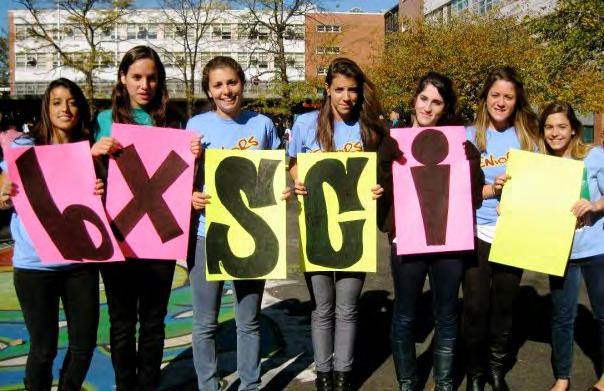
“Whenever somebody asks me about Bronx Science, I always say, the school is an amazing resource—just being surrounded by people as motivated as those students really rubs off on you and remains with you throughout your whole life,” Narov reflected. As a student, Narov spent much of her time engrossed in the rich humanities curriculum that Bronx Science provides. She stated, “I
have to correct people when they assume it's strictly a science school- there is a strong humanities background that has enabled me to structure ideas clearly and communicate them well, which have served me well in my career.”
She recalled her time working on the Bronx Science yearbook and on Dynamo, the literary magazine. She stated that the student-led nature of these programs taught her skills and initiative needed to thrive in a collaborative work environment, similar to the environment she thrives in today. It was this writing that inspired her to apply to the University of Michigan as an English major and write for the college paper, The Michigan Daily. She reflected, “When working for my college paper, one of my assignments was to interview a former president of the university, who was publishing about betterment for the Midwest, specifically educational attainment in Detroit. It was working for the paper and through oncampus activism that I first became exposed to the realities of the issue of education inequity.”
Narov’s extensive AP credits from Bronx Science served her well, allowing her to graduate early, lending her the time to pursue other work such as volunteering in a Detroit classroom. While volunteering,
she was introduced to Teach for America, a nonprofit organization dedicated to addressing educational inequality around the nation. Narov noted, “Because I was a benefactor of an amazing public school education in New York City, I believe in our public school system’s ability to deliver and wanted to be in service of that.” Narov chose to pursue Teach For America closer to home in the Northeast, landing at Camden Street Elementary School in Newark, New Jersey.
While in Newark, Narov taught third grade science and mathematics, while also serving as the technology lead for over 50 teachers. However, she chose not to remain in education long-term as she had a growing interest in business development. A former Bronx Science classmate referred her to a job at Google, another data point in what Narov observed as "the most pervasive pattern in my career was simply the network of people that I met at Bronx Science."
Narov started her career at Google as a Business Operations Lead, a relatively entrylevel position. “At Google many people bring nontraditional backgrounds to the table. Not everyone has a master's in engineering. As a Business Operations Lead I was practically a support specialist, tasked with simply explaining programs and products. As explaining is not too different from teaching, my background made me a perfect fit.”
Once at Google, Narov thrived and quickly advanced. “A lot of my internal movement within Google has been through connections I've made, or network growth,” she stated. “I think Bronx Science really fosters that idea of just naturally creating those connections.”
Now, less than ten years later, Narov is
a Global Product Lead, tasked with collaborating with product and engineering teams to determine what they should build on the basis of what the top business needs currently are. She then partners closely with sales departments on product delivery and publicity based on potential launches.
Her work in the field of education hasn’t ended, however - just evolved by returning to her roots. Narov is passionate about her work with Bronx Science today, volunteering with the Summer Institutes and exposing current students to career opportunities in tech. She also offers significant time and support for our college programs, such as Project Accepted, helping students practice their interview skills. "I am so excited to work with Bronx Science students because there is so much enthusiasm and motivation that cannot be found anywhere else,” said Narov. “As an alum, it is very fulfilling to have the opportunity to create these connections with the school and its students.”

ARTICLE BY ANNA KOONTZ ̓25
The following article was published in the Science Survey in October 2024. Martin Afromowitz passed away on November 19, 2024.
When Martin Afromowitz ’62 took the SHSAT, he left the testing facility with a sinking feeling. He had skipped one question early in the exam but forgot to leave it blank on his bubble sheet. In the last remaining seconds, he realized that almost all of his responses were one question off. “I went home very depressed, but I decided I was going to write a letter to Bronx Science,” he remembered. He paused, laughing, then imitated his teenage self: “Could you please go back and adjust all my answers and switch them by one, starting at question 13? I would be very grateful.”
asked about his decision to donate. “The work that I did and the pleasure that I got from it was so strongly attributed to what I learned at Bronx Science. I felt I had to give back to the school.”
From a young age, math and science fascinated Marty. He grew up deconstructing radios, watches, and other broken pieces of household technology. As an eighth grader, he selfdiscovered integral calculus while pondering how to determine the volume of a glass. He imagined the irregularly-shaped object as a stack of infinitely thin disks, of which he could calculate and add together the individual volumes.
Marty described Bronx Science—with its rigorous curriculum and advanced STEM classes—as “the answer to my dreams.”
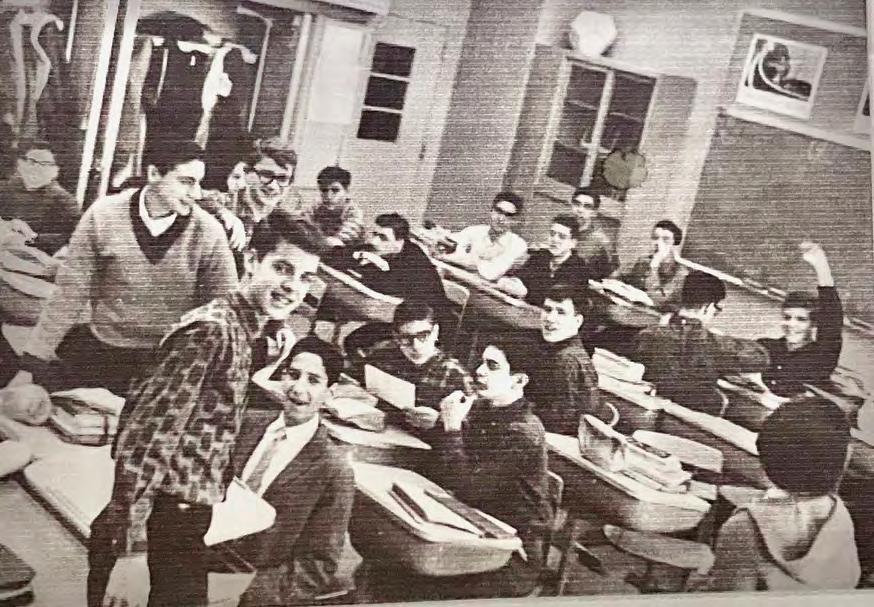
Amazingly, the school reviewed his answer sheet again, and Marty was accepted. This second chance was only the first of many opportunities that Bronx Science would provide him. Now, Marty is giving back to the school with a generous $200,000 donation.
“Bronx Science shaped my career in so many different ways,” said Marty when
He was immersed in a supportive community of “fantastic teachers” and “terrific friends,” some of whom he still stays in touch with through monthly zoom meetings. Marty became especially close with Dr. Abraham Baumel, a physics teacher whose office hours felt like a second home.
“His door was always open. And we sat around and just BS’d about physics,” Marty remembered. “He just enjoyed interacting with us. Dr. Baumel was the first one that I asked to sign my yearbook.”
After high school, Marty attended Columbia University, earning his Bachelor’s, Master’s, and PhD in electrical engineering. Then he worked for Bell Labs in New Jersey, where he had his own laboratory, lab assistant, and highquality equipment. Marty’s work was significant in developing the light emitting diodes, or LEDs, that have become commonplace today. “It’s been a marvelous explosion of technology… and I’m very excited that what I was involved in early on in my career has become so useful to mankind.”
treasures his senior yearbook, which he flipped through as we spoke.
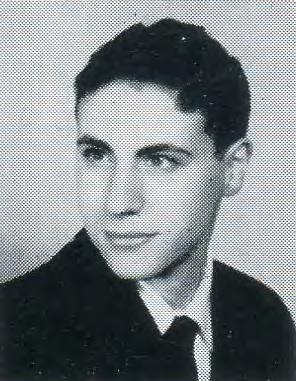
Pausing on the first page of the inside cover, his eyes teared up as he read aloud the note from Dr. Abraham Baumel:
In 1974, antitrust investigations began to threaten the Bell System, and Marty moved to the University of Washington to conduct research in bioengineering. Eventually, he became a full-time professor at the university. “I can’t explain or express how great it is to be a professor,” Marty said. “You’re interacting with young, really smart people. They’re eager to soak up all the knowledge you can give them.”
Like Dr. Baumel, Marty delighted in talking with students after class and explaining scientific concepts.
Later in life, Marty also served as an expert witness in patent litigation, evaluating the validity of patents and using his expertise to testify in court. In 2015, he concluded his 41-year-long teaching career and retired from the University of Washington.
Over sixty years have elapsed since Marty was a student at Bronx Science. However, he identifies as a proud member of the Bronx Science community and returned for his 25th and 40th class reunions. He still
It is difficult to thank you for all the things you have done for me. But above all, your good humor, your superb work, your wonderful character, all will remain with me as an echo of a most wonderful year. Best wishes for future success—you will succeed most admirably. Marty shared his amazement that Dr. Baumel—a mentor he felt so indebted to—was the one saying ‘thank you.’ It was the school and teachers who deserved the utmost thanks, Marty thought, for their dedication and profound influence on his life. His $200,000 donation is an expression of this gratitude and an assurance that Bronx Science will continue to be a transformative place for all current and future students.
The school plans to use these funds to support students living under the poverty line and provide computers, books, and other resources. Marty hopes that students benefiting from this today will be inspired to similarly donate at the end of their careers, if they have the resources to do so. “I’m just thrilled that I can give back,” Marty reiterated, smiling. “It would be nice if these students continue the tradition.”
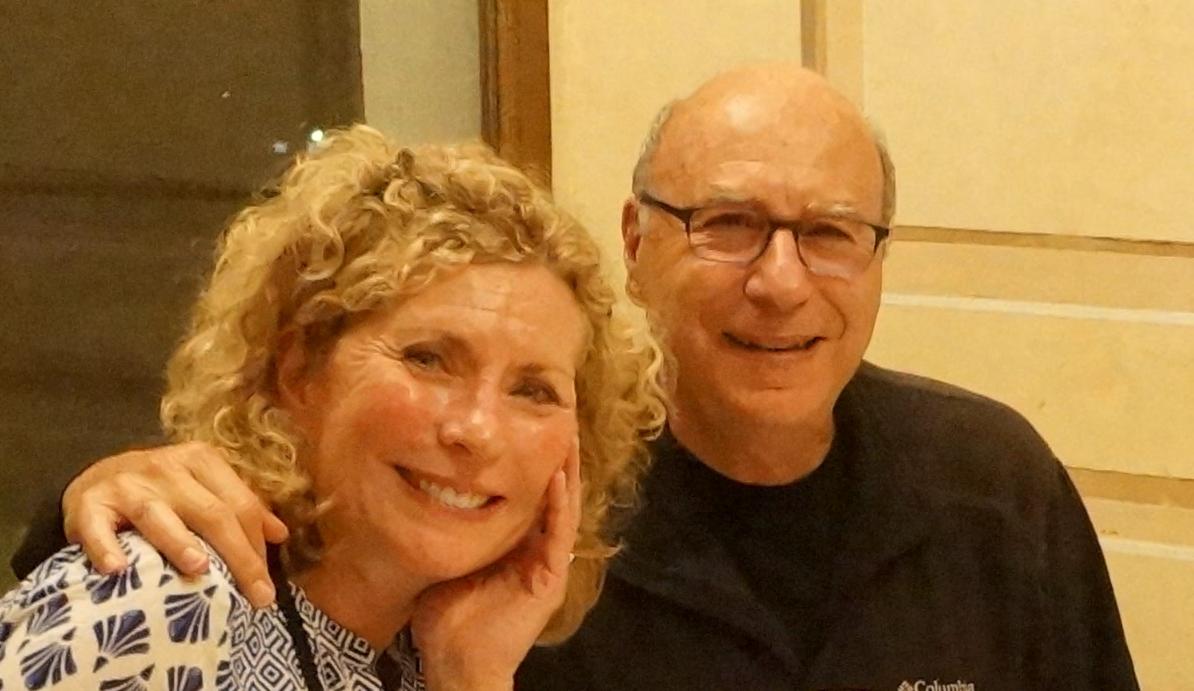
Daniella Lednicer shared, “Oliver Lednicer ’52 was a Bronx High School of Science alumnus who fled Europe from the Nazis in 1940 with his immediate family, and eventually found safe haven in the United States. He and his wife, Sylvie Lednicer, were deeply dedicated to Holocaust education, and ensuring future generations learn the crucial lessons this history holds for us.
We feel deeply privileged to present this gift of $20,000 to the Holocaust Museum at the bequest of our father, Oliver Lednicer, a true mensch in every sense of the word.”
Lori Zoppel Wasserman ’73 shared, “I was watching the latest Elton John movie, It’s Never Too Late, and I noticed two 1973 alumni—me and Joseph Sachter, in a photo from Elton John’s 1971 Carnegie Hall concert. We were dating at the time. It is so crazy that I would notice us in what was on screen for 2–3 minutes. I think it would be fun for alumni from our class to see this.”
Matthew Eisenberg ’65 has written a book titled: “Confidence Skills for Young Adults
His goal is to “raise the consciousness and morality level of society starting with our young adults.” It is available on Amazon, and offers for free e-book copies can be found here.
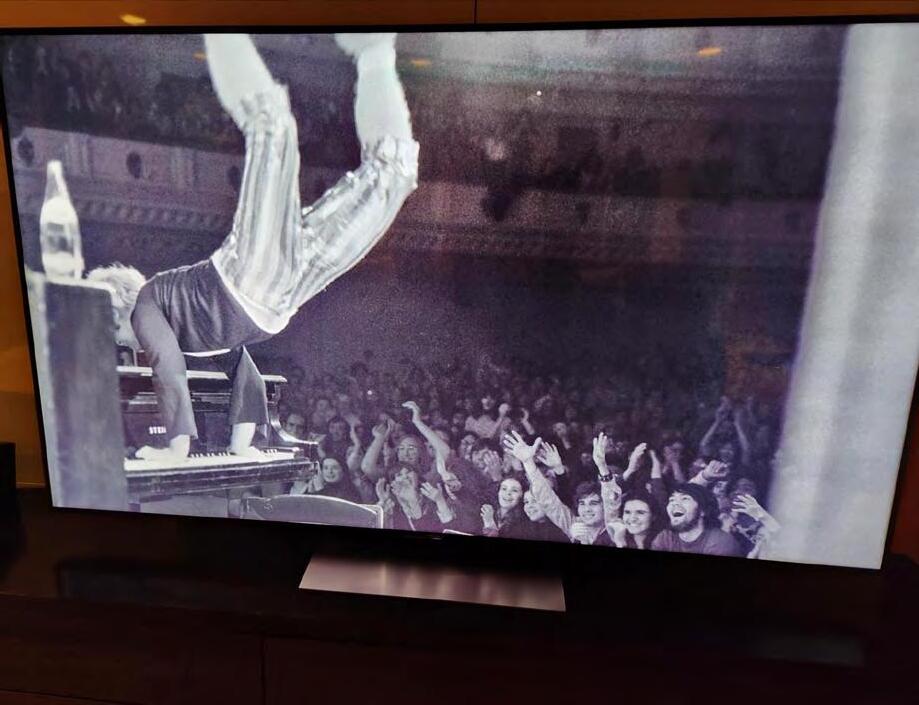
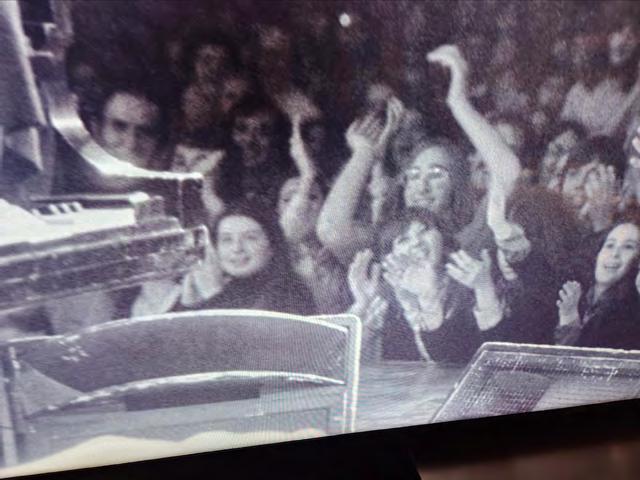
David Blumenthal ’98 has been promoted to Vice President of DOTmed. com, the world’s leading online medical equipment marketplace. In his new role, Blumenthal will oversee the advertising sales force, service major accounts, and drive customer acquisition and retention. Please find his full story here.

We are saddened to share news that the following Bronx Science alumni have passed away. Our thoughts are with their friends and loved ones.
Eugene Miller ’42
Milton Fruchtman ’44
Herbert Rothenberg ’45
Bruce Ames ’46
Leon Cooper ’47
Stanley Hirsch ’47
Kalman Vitez "Kal" Illyefalvi ’47
Barney Schwalberg ’47
Herbert Felsenfeld ’48
Eugene Miller ’49
Stuart Rice ’49
Gerald Kadish ’50
Stanley Lubman ’51
Stuart Tell ’51
Elaine Brenner Feldman ’52
Phyllis Papier Goodfriend ’52
Loretta Langhans Van Vugt ’52
Ronald Lewis ’53
Sondra Yoskowitz (Helfand) ’54
Nathaniel (Pete) Gelb ’55
Diana Laster Berliner ’56
Nancy (Ruppert) Hersch ’56
Jay Herzog ’56
Beverly Weinstein ’56
Laurence Fisher ’57
Elliott Mittler ’58
Ira Ockene ’58
Robert Edward Sobel ’58
Richard Glass ’59
Arthur Silver '59
Harry Marten '61
Martin Afromowitz ’62
Jane Bunin ’62
John Brusko ’63
Lewis Friedman ’63
George Lazarus '63
Susan Reisler ’65
Charlie Lichtman ’66
Sondra (Sunnie) Brown ’67
Carl Schwartz ’67
Kenneth Marlowe ’75
Gail Mazin ’83
Dino E Browne ’84
Rachel Cane ’84
Justin Seto ’85